Brand Is Getting A “Rebrand” — Thank You, AI!
Brand is having a glow-up, and AI is the glam team behind it.
![]()
Brand is having a glow-up, and AI is the glam team behind it.
![]()
Verbosity is the new brevity.
Google felt like a miracle. We could type just a word or two (“blog“) and it would magically guess what we wanted and take us there.
This shortcut spread from Google to the search built into online shopping as well. How convenient. A few words and done.
AI isn’t like that. In fact, our concision is getting in the way of the insight we’re looking for.
Go to Etsy and search for “white pants” and you’ll get more than 10,000 matches, most of them useless. Instead, type “white pants to wear to a wedding in July in lower michigan for a 30 year old woman” and you’ll get this.
AI systems like Claude and ChatGPT let you attach a PDF or text file to your query. Here’s the useful hack:
Create a document that has pages of background.
Your medical history for example. Include your age and every interaction you’ve had with the medical system, including illnesses and drugs and outcomes. Now, every time you ask a health question, attach the document.
Or, a copy of your resume, work history, letters of recommendation and career goals, all in a PDF. Upload it every time you’re asking for career advice.
It works for business plans, for customer lists and even legal documents. Upload an entire email correspondence, or a fifty page wine list.
AI isn’t impatient, easily bored or distracted.
It’s insatiable.
PS chat GPT knows a shocking amount about you, while Claude starts over every time. Neither promises airtight security, but then again, neither does American Express, Visa or Google…
Cindy Krum tells Shelley Walsh why SEO professionals are missing the bigger picture in Google’s AI evolution: personalization, ads, and multi-platform search.
The post Google’s AI Search Journeys Are Reshaping SEO With Cindy Krum appeared first on Search Engine Journal.
Google’s new Offerwall feature lets publishers monetize through surveys, ads, or micro payments. Could this reshape your revenue strategy?
The post Google Launches Offerwall To Expand Monetization Options appeared first on Search Engine Journal.
Medical Miracles.
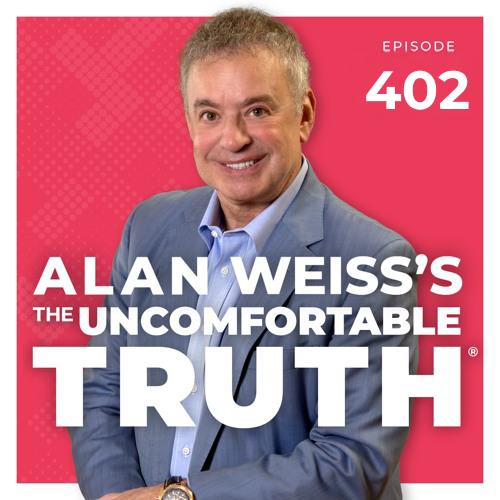



Alan Weiss is one of those rare people who can say he is a consultant, speaker, and author and mean it.
His consulting firm, Summit Consulting Group, Inc., has attracted clients such as Merck, Hewlett-Packard, GE, Mercedes-Benz, State Street Corporation, Times Mirror Group, The Federal Reserve, The New York Times Corporation, Toyota, and over 500 other leading organizations. He has served on several boards of directors in various capacities.
His prolific publishing includes over 500 articles and 60 books, including his best-seller, Million Dollar Consulting (from McGraw-Hill) now in its 30th year and sixth edition. His newest is Your Legacy is Now: Life is not about a search for meaning but the creation of meaning (Routledge, 2021). His books have been on the curricula at Villanova, Temple University, and the Wharton School of Business, and have been translated into 15 languages.
Fight, Flight, Fright, or Fall Down Quaking
We feel powerless in an age of volatility and disruption, of lack of trust in our institutions, and of polarization among those supposed to represent our best interests and not merely their own.
Fight or flight has added fright to the equation, but it seems to me there’s also the new option of hiding under the bed (fall down quaking). Whining has become a national past time, and we hear of “toxic bosses, poisonous workplaces, unfair demands, too little pay for too much work. And the anodyne solutions is “soak the rich, tax the wealthy, take back….well, whatever.”
Those experiments in Seattle and Portland, which were actually anarchic takeovers and the end of law and order didn’t work out so well, did they? The Great City of San Francisco, where we lived for a glorious while in the 70s is not filthy and dangerous in many areas. The homeless often physically confront pedestrians.
At least we don’t hear “defund the police” so much anymore, since it’s such a stupid concept. The homeless, the mentally ill, deserve and require empathy beyond a police response. But when the bad guys are trying to break the law, trying to steal, trying to create chaos, we need more police not fewer.
In the long run this is about perceived powerlessness. We’ve lost faith and thereby feel alienated, which causes us to “drop out” (not vote) and the results are the greater influence of those with whom we don’t agree, creating a greater sense of powerlessness and a “doom loop” exsistence.
There are a lot of positive things going on in the country, and other things that well-meaning people would like to change. Fair enough, but that takes will power and relative fearlessness, not some kind of hibernation.
At least we’ve stopped taking the names of the Founding Fathers, Lincoln and others off of public buildings. We’re more concerned about gender and bathrooms today than we are with public welfare, quality education, and decency.
Fortunately, the system is brilliant and survived, made to endure even when run by idiots from either party.
Alan Weiss’s The Uncomfortable Truth® is a weekly broadcast from “The Rock Star of Consulting,” Alan Weiss, who holds forth with his best (and often most contrarian) ideas about society, culture, business, and personal growth. His 60+ books in 12 languages, and his travels to, and work in, 50 countries contribute to a fascinating and often belief-challenging 20 minutes that might just change your next 20 years.
Introduction to the show recorded by Connie Dieken
Brand authority and conversions don’t need separate content strategies. Mordy Oberstein explains how to align both in this week’s Ask An SEO.
The post Ask An SEO: Balancing Content That Converts With Content That Builds Brand Authority appeared first on Search Engine Journal.


At Buffer, we don’t just write about social media — we study it.
This living resource curates every original data report we’ve published, from platform-specific trends to posting strategies that actually work.
Whether you’re a creator, marketer, or small business owner, these insights can help you make smarter content decisions backed by real numbers.
Before diving into the numbers, here are a few important notes to keep in mind:
Here are some terms you’ll run into throughout this page and what they mean.
→ The percentage of people who interacted with your post out of the total who saw it.
How we calculate engagement rate:
(Total Interactions ÷ Total Impressions) × 100
Average
→ The sum of all engagement rates divided by the number of posts. Helpful for comparing platform performance overall.
Median
→ The “middle” value in a list of engagement rates. It removes outliers and gives a clearer picture of typical performance over time.
Reach
→ The number of unique users who saw your post — one of the best indicators of how far your content traveled.
Watch time
→ The total time people spent watching your video. For TikTok, YouTube Shorts, and Reels, this is often more important than views or likes.
Post consistency
→ How often you post over a given time period. In our studies, “consistent” typically means posting at least once a week for 5+ weeks.
These reports will help you understand what’s normal on social media — and what it takes to stand out.
To determine where users are engaging the most, we analyzed average and median engagement rates across eight major social platforms over a full year.
The findings reveal not just which platforms perform best, but how engagement is shifting over time — and what that means for your content strategy.
We checked for average engagement first, which helps us compare platforms at a high level, showing where engagement is strongest overall.
This snapshot reveals where content tends to get the most traction overall — and where high visibility doesn’t always translate to high engagement.
So, in ranking order:
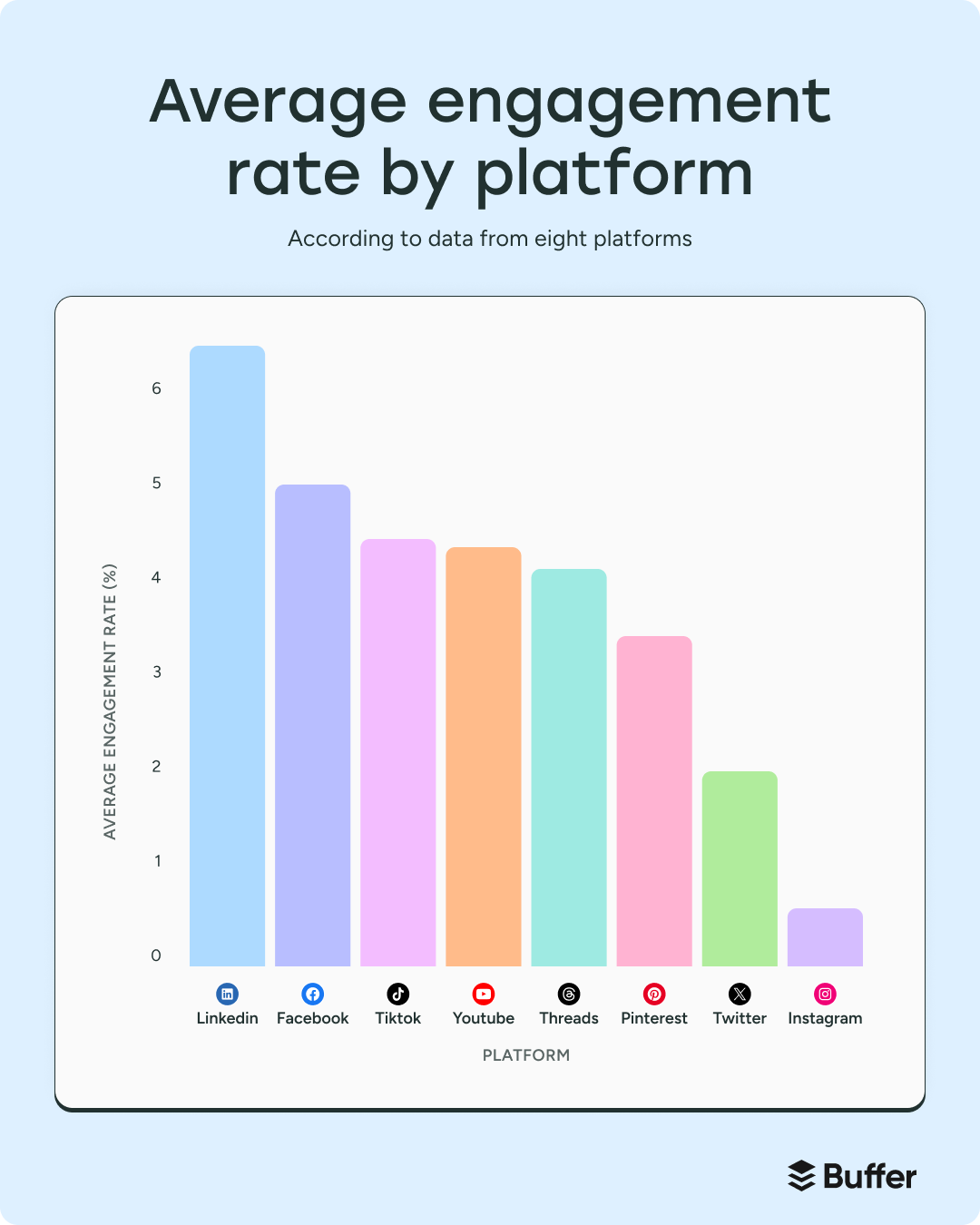

Of course, averages can be skewed by a few viral hits. That’s why we also looked at median engagement over time — to understand what the average creator is experiencing month to month.
We found that some platforms are rising, others are holding steady, and a few are clearly slipping.
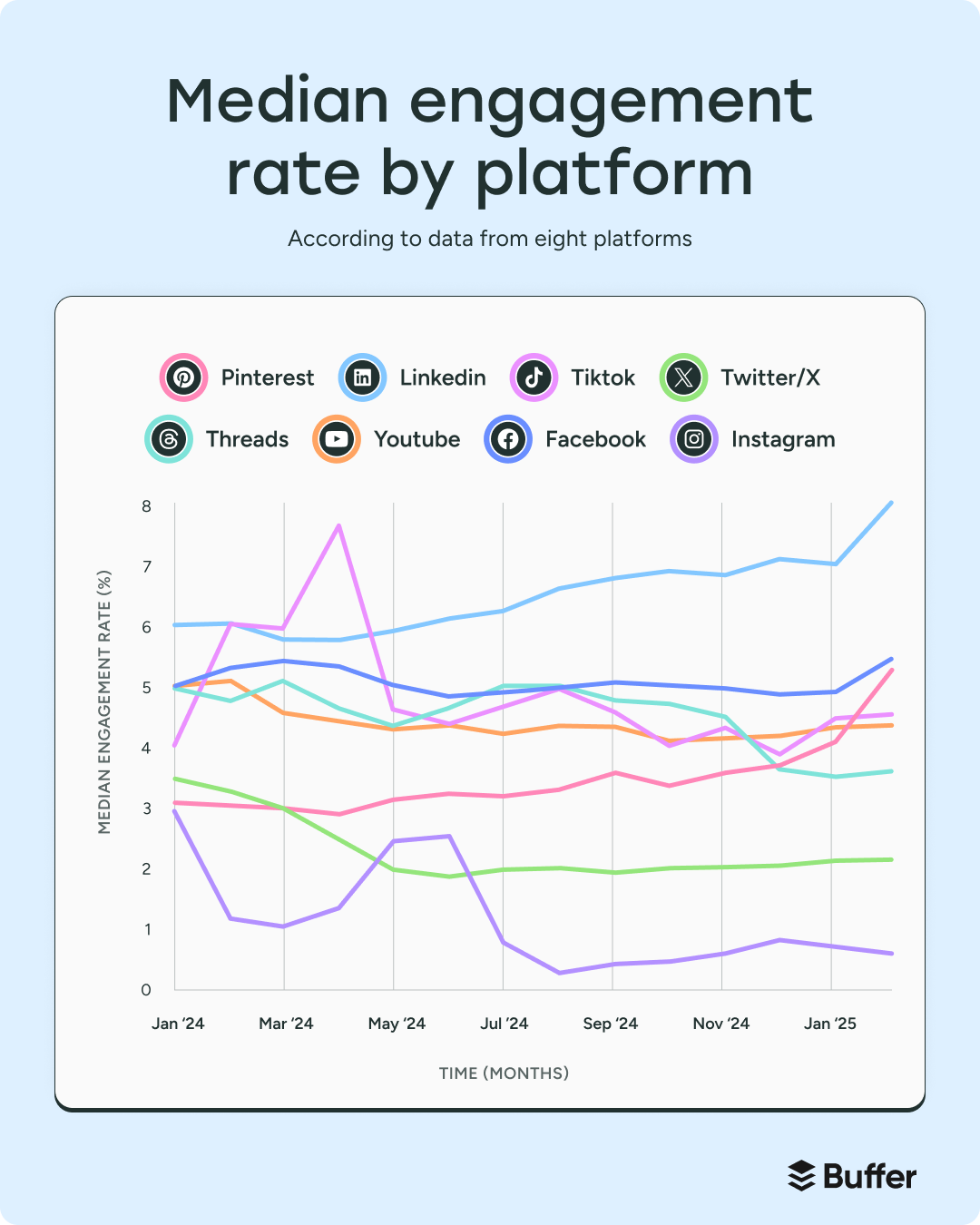

These numbers aren’t just for comparing platforms — they tell a story about where attention is moving, how users are engaging, and what kind of content each platform now rewards.
LinkedIn is now the strongest platform for organic engagement, climbing to an 8% median — a huge opportunity for thought leaders. Threads started strong and still beats X, but engagement is beginning to normalize as the platform matures. X/Twitter is declining — the lowest median and average engagement of any platform studied.
Instagram’s public engagement is dropping fast, but that doesn’t mean users aren’t interacting. DMs, shares, and saves may be growing behind the scenes. TikTok still performs well, but watch time is overtaking likes and comments as the key signal of success. YouTube Shorts is a rising star, with median engagement trending up month over month.
Pinterest is quietly outperforming more talked-about platforms, especially for evergreen content. Meanwhile, Facebook remains consistent, driven in part by active Groups and local communities.
We looked at over 100,000 Buffer users across a 26-week period to answer one question:
Does posting consistently really make a difference?
Short answer — yes. A big one.
What happens when you show up week after week? Creators who posted at least once a week for 20+ weeks saw 450% more engagement per post than those who posted fewer than five times across the same period.
→ Just five months of consistent weekly posting = 4.5× more engagement per post.
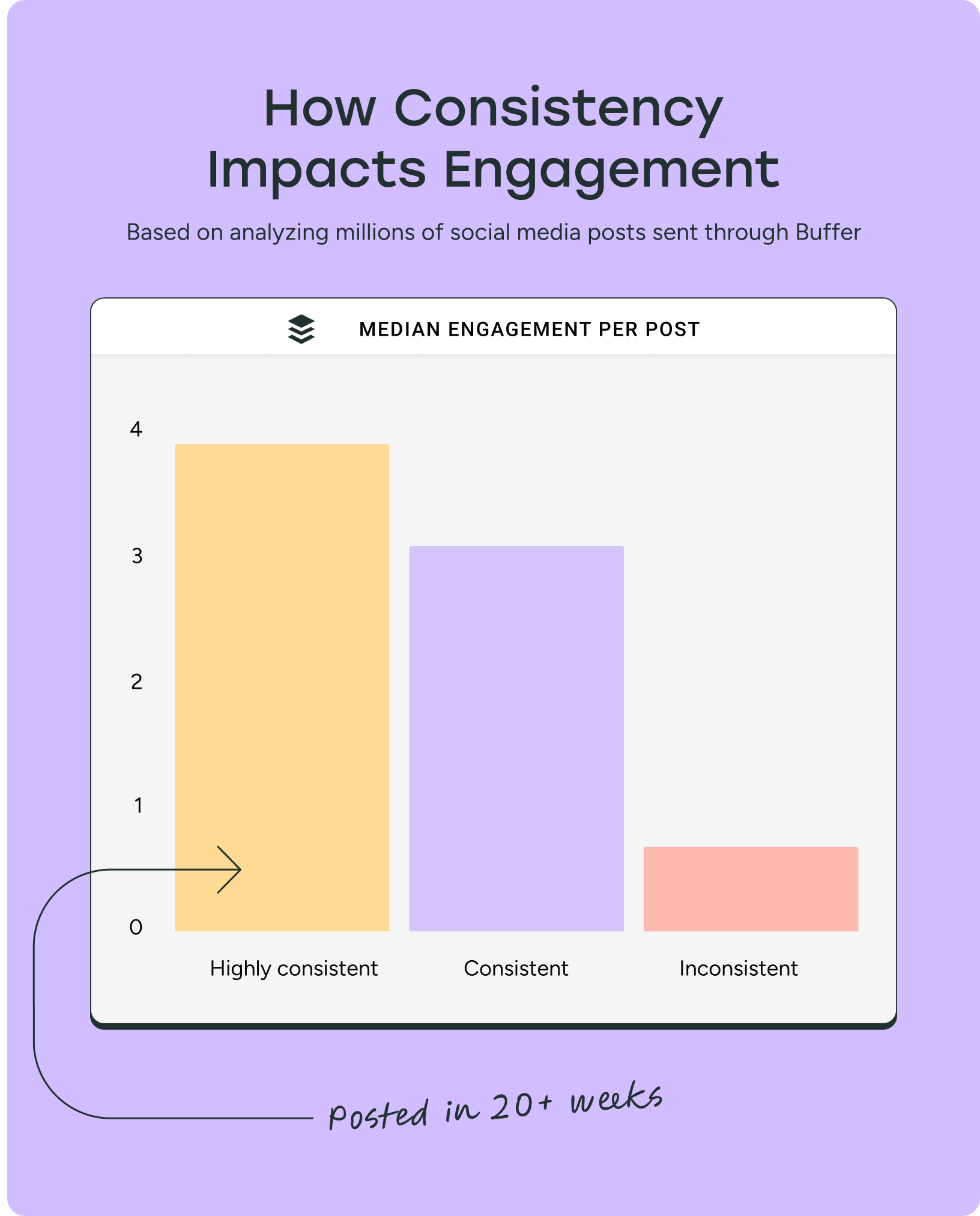

Even creators who posted consistently for just 5–19 weeks earned 3.4× more engagement than the least consistent group. Showing up just one month more than usual can meaningfully shift your results.
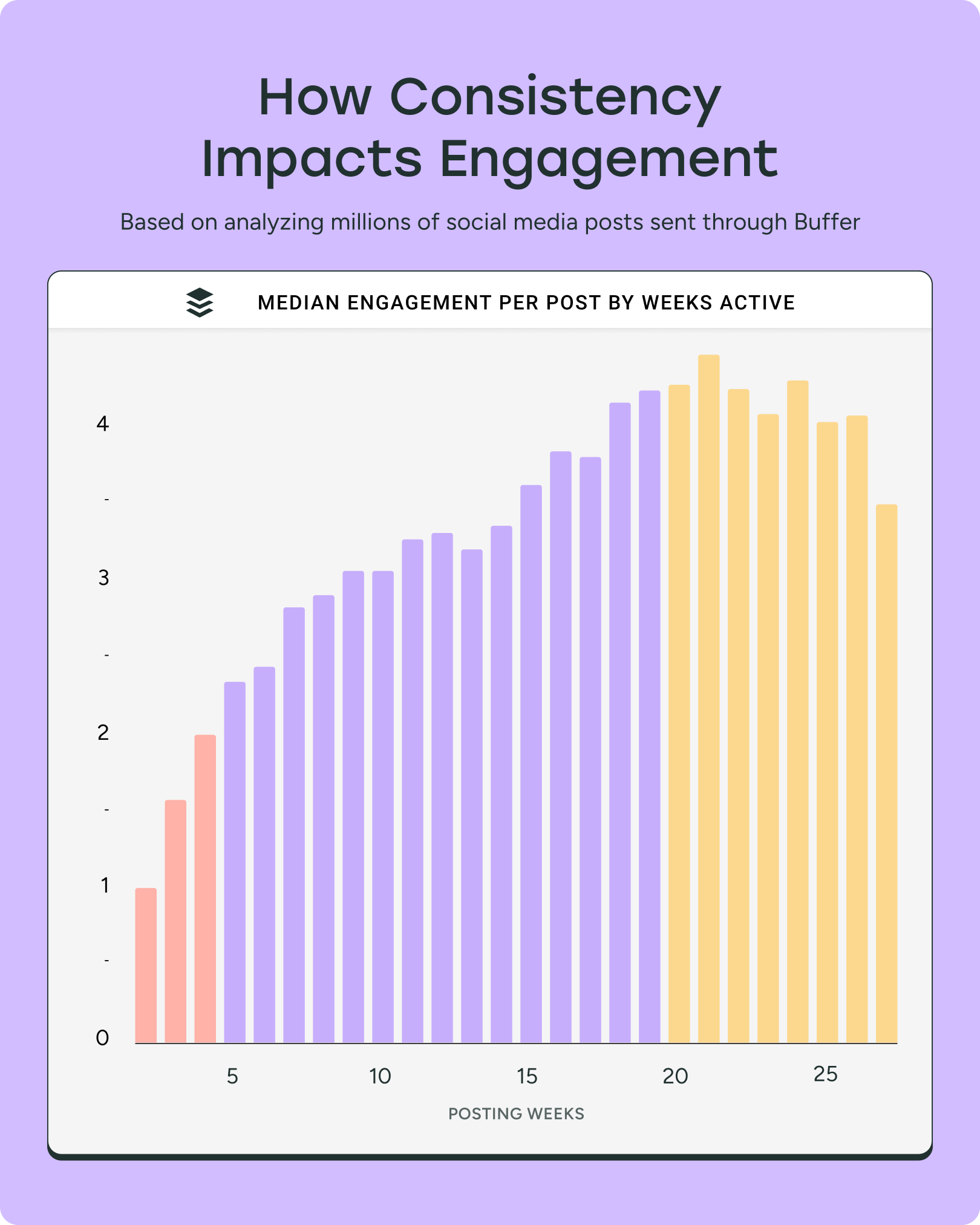

Engagement peaked around the 21-week mark, with a median of 4.47 interactions per post. After that, returns began to level off — a sign that consistency matters more than volume.
This pattern held across platforms — whether it was Threads, Instagram, or LinkedIn. It’s not about going viral once. It’s about building predictable engagement over time.
Consistency compounds. If you’re looking for one high-impact habit to build, make it this: post once a week, every week.
Even short posts. Even if it’s not perfect. The results are clear — frequency breeds familiarity, and familiarity builds engagement.
So far, we’ve seen how engagement rates and consistency shape performance. But what about how the content gets made — and whether AI can help?
To understand how AI is shaping content performance, we analyzed 1.2 million posts across six major platforms — comparing posts written entirely by humans to those created with help from Buffer’s AI Assistant.
Spoiler: AI didn’t just help people write faster. It also helped them post smarter — and more often.
AI-assisted content saw ~22% more engagement than non-AI-assisted posts.
The median engagement rate jumped from 4.82% to 5.87% when AI was used — a meaningful 22% boost.
Platform-level gains ranged from +5% on YouTube to +100% on Threads, showing that some platforms benefit more from AI-written formats than others.
But this wasn’t just about writing style — creators using AI also posted more often and refined their content faster, which contributed to stronger performance.
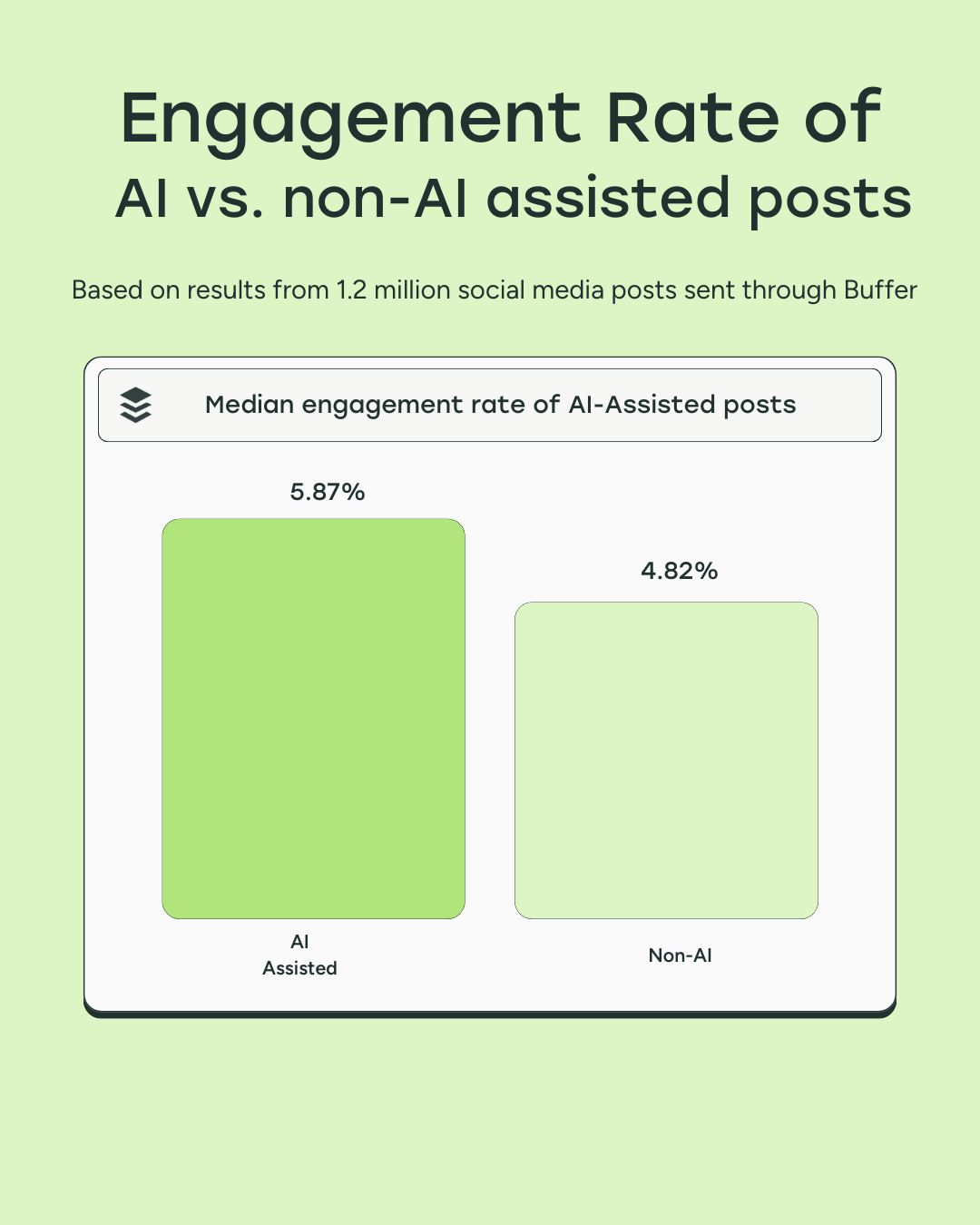

AI isn’t magic — but it is momentum.
Tools like Buffer’s AI Assistant can help you get past the blank page faster, test out new angles, and stay consistent.
These small productivity gains stack up. Better hooks, clearer formatting, and stronger CTAs can all contribute to higher engagement — even if the post was your idea from the start.
In short? AI can help you publish more of your best work — more often. And as AI tools become more embedded in everyday workflows, the line between ‘AI-assisted’ and ‘human-created’ will blur — but the goal remains the same: showing up consistently with content that connects.
Get the edge on each platform with unique performance and usage patterns.
Everyone talks about TikTok as a short-form platform — but the data tells a different story.
We analyzed 1.1 million TikTok videos to find out how video length affects performance. The results challenge the idea that shorter is always better.
To start off, we checked what everyone is already doing and most TikToks — 86% — are under 60 seconds. But surprisingly, creators who go longer are reaping the rewards.
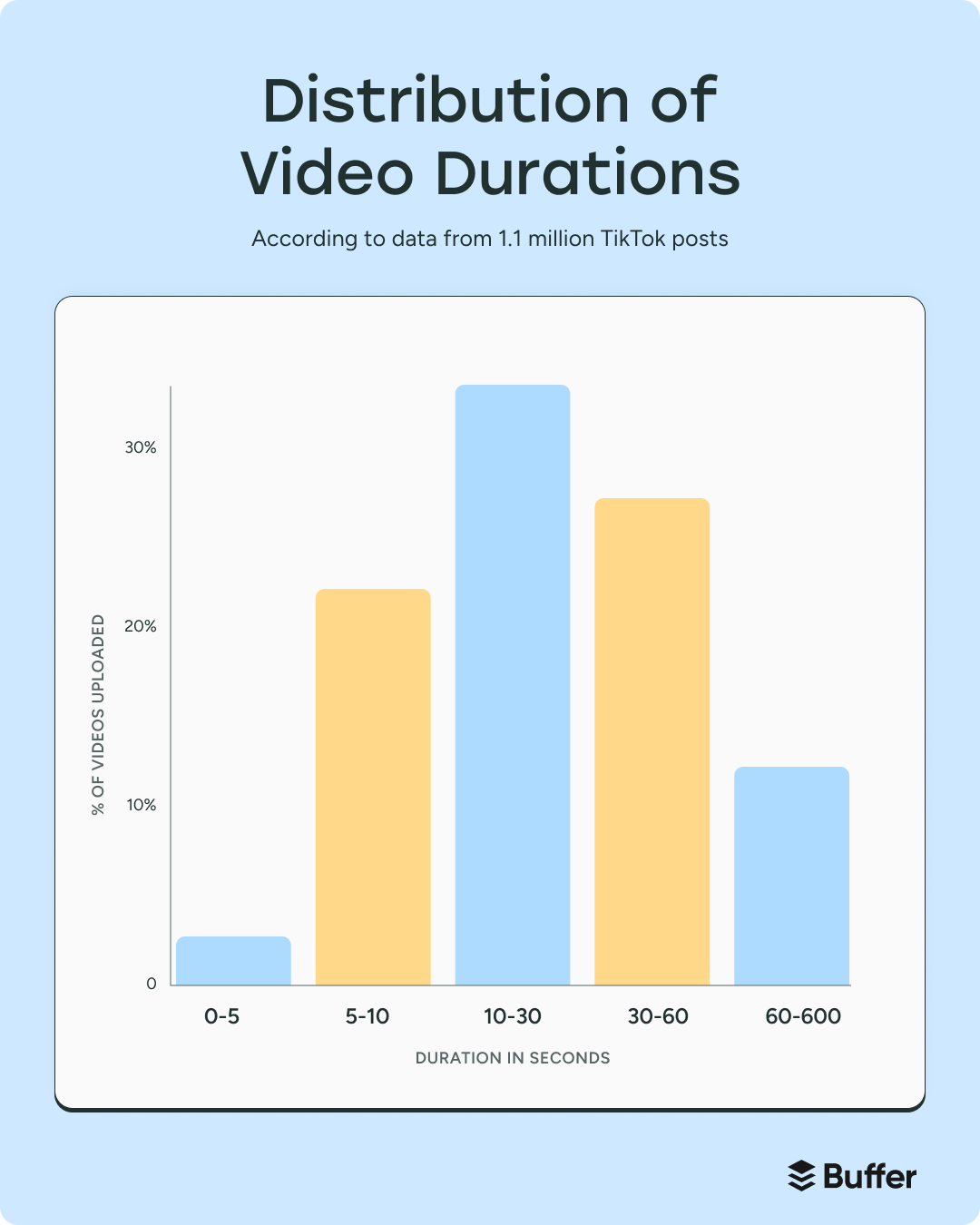

Compared to mid-length videos (30–60 seconds), TikToks over 60 seconds earned:
And when compared to ultra-short clips (5–10 seconds), the results are even more dramatic, with videos over 60 seconds seeing:
Even 30–60 second clips saw solid wins over shorter content:
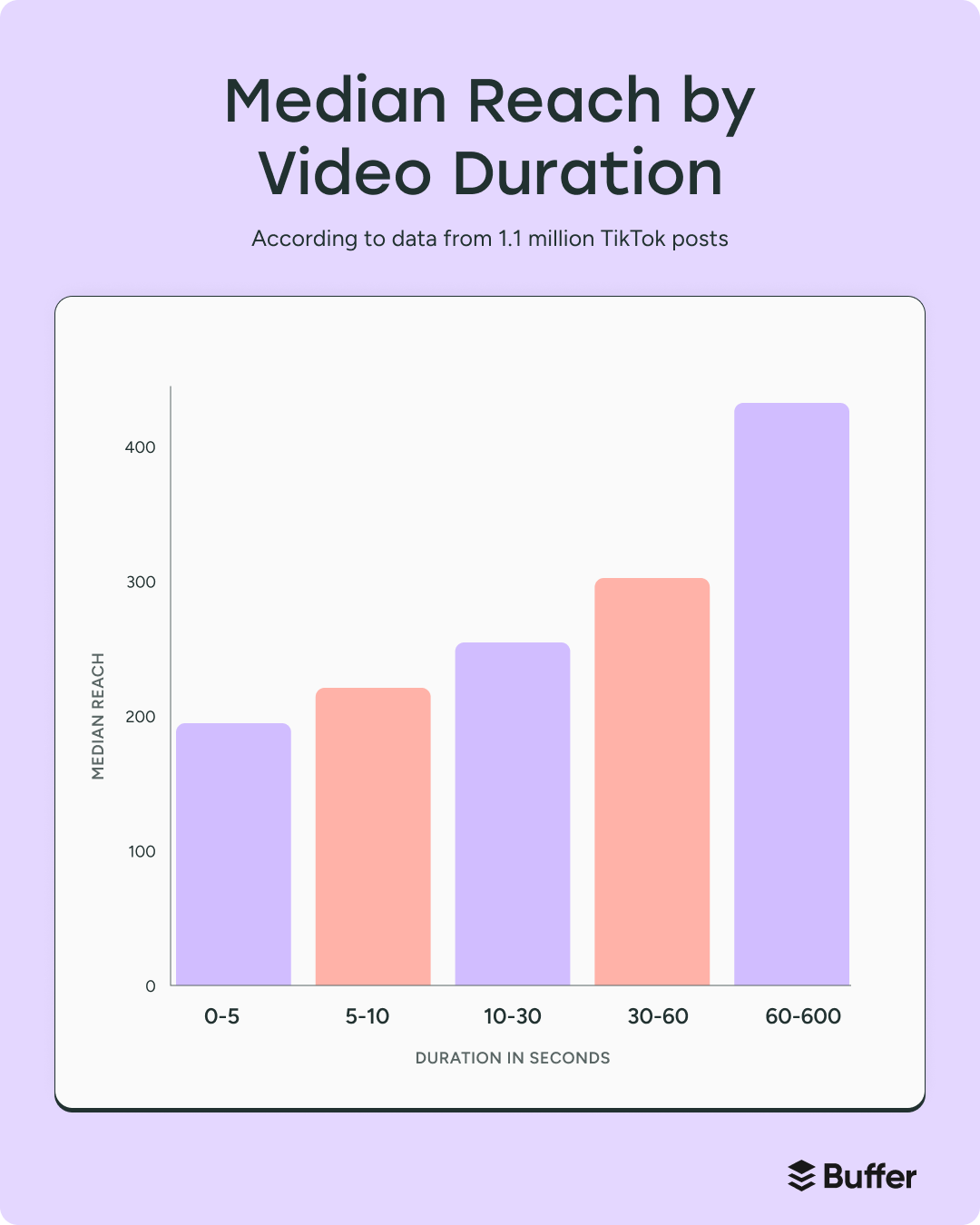

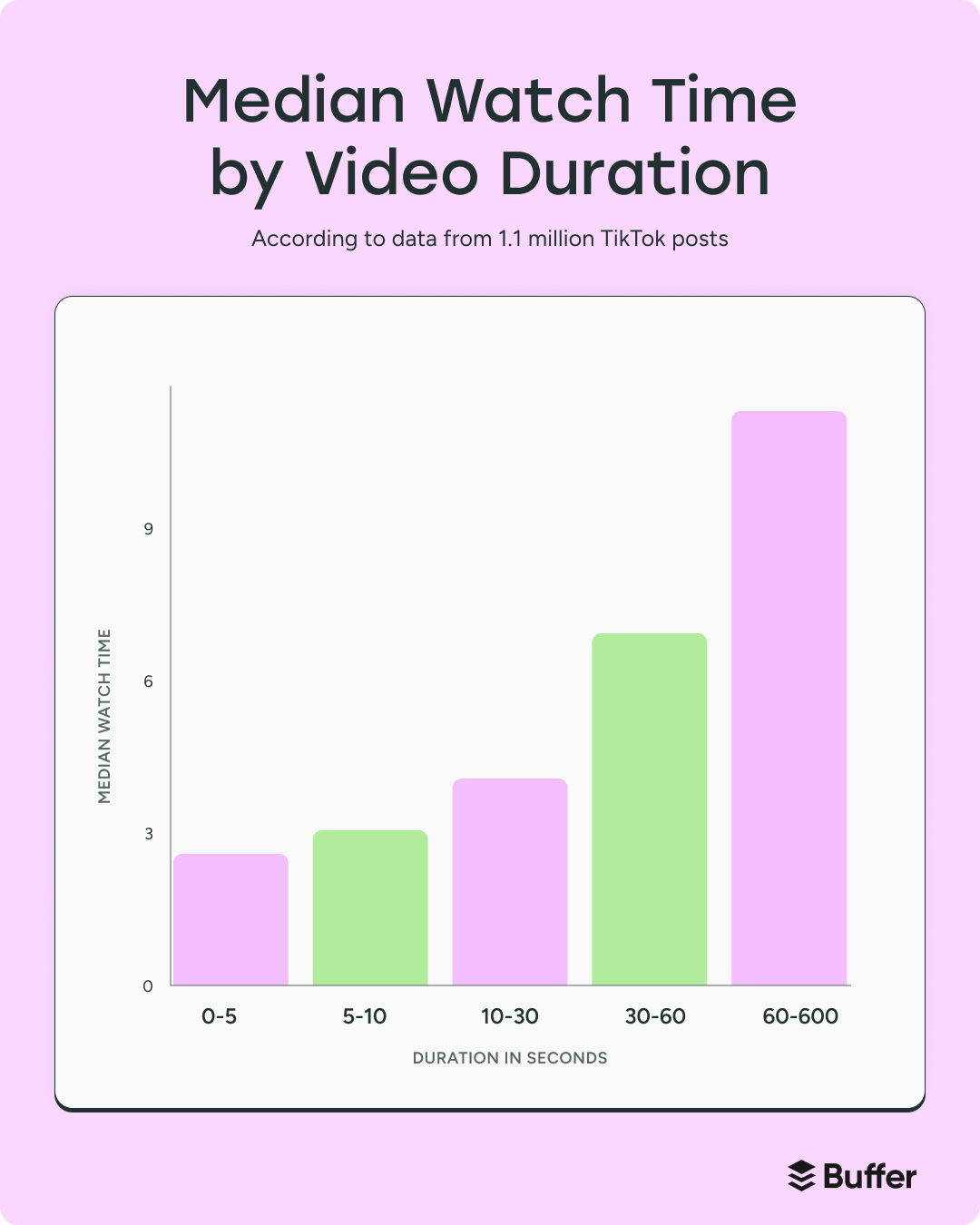

If you take nothing else away from this section, take this: create videos that are 60 seconds or longer.
Even mid-length videos of 30-60 seconds consistently produce stronger results than ultra-short clips.
Finally, remember: the algorithm rewards watch time, but quality still wins. A strong first few seconds matter just as much as length, so hook fast, then deliver.
We analyzed over 4 million Instagram posts from 2022 to late 2024 to understand how content format affects both reach and engagement.
Our data revealed that reels and carousels both have strengths — but they serve different goals.
Reels drive discovery. On average, Reels earned:
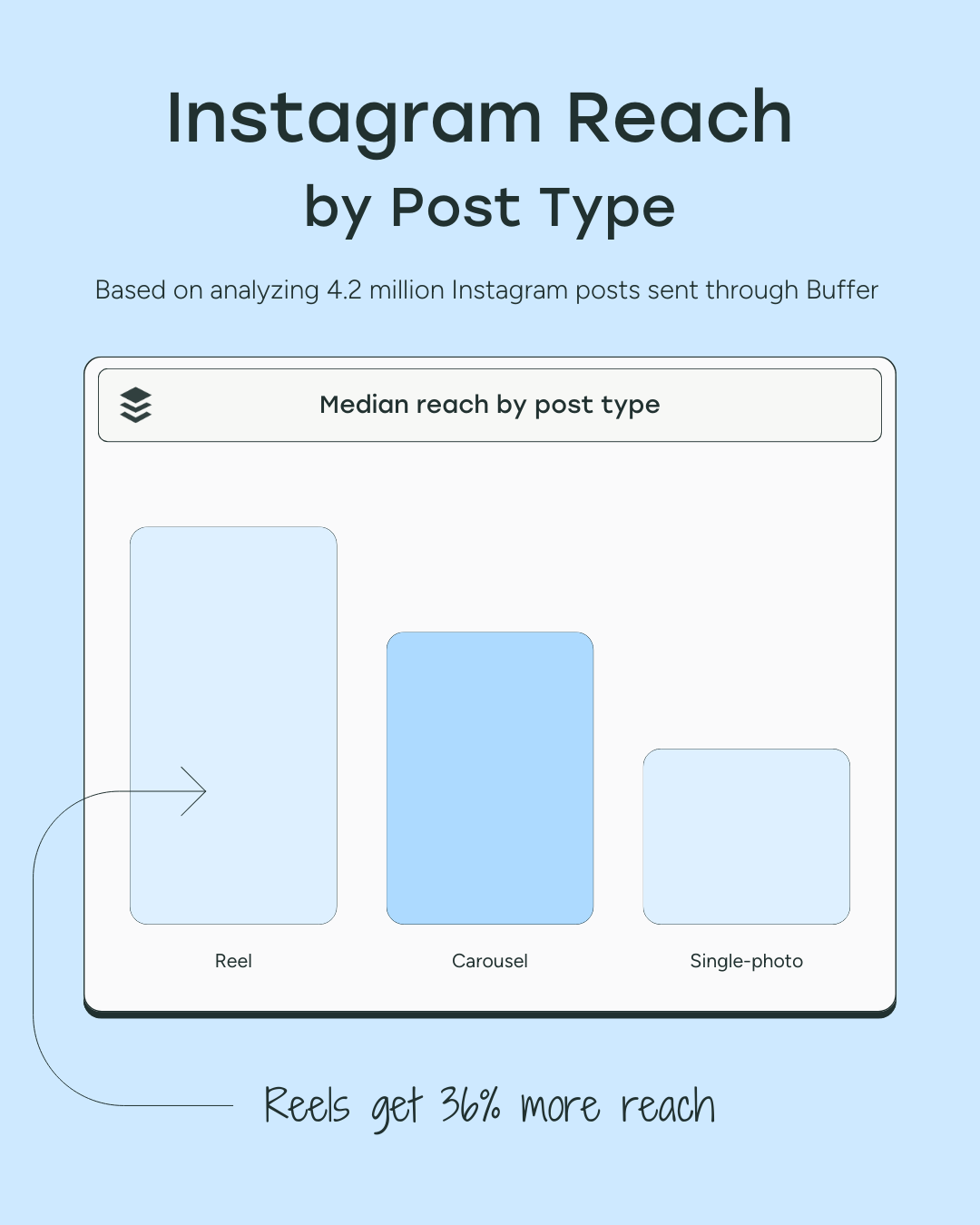

Carousels drive engagement. They outperformed other formats when it came to interactions:
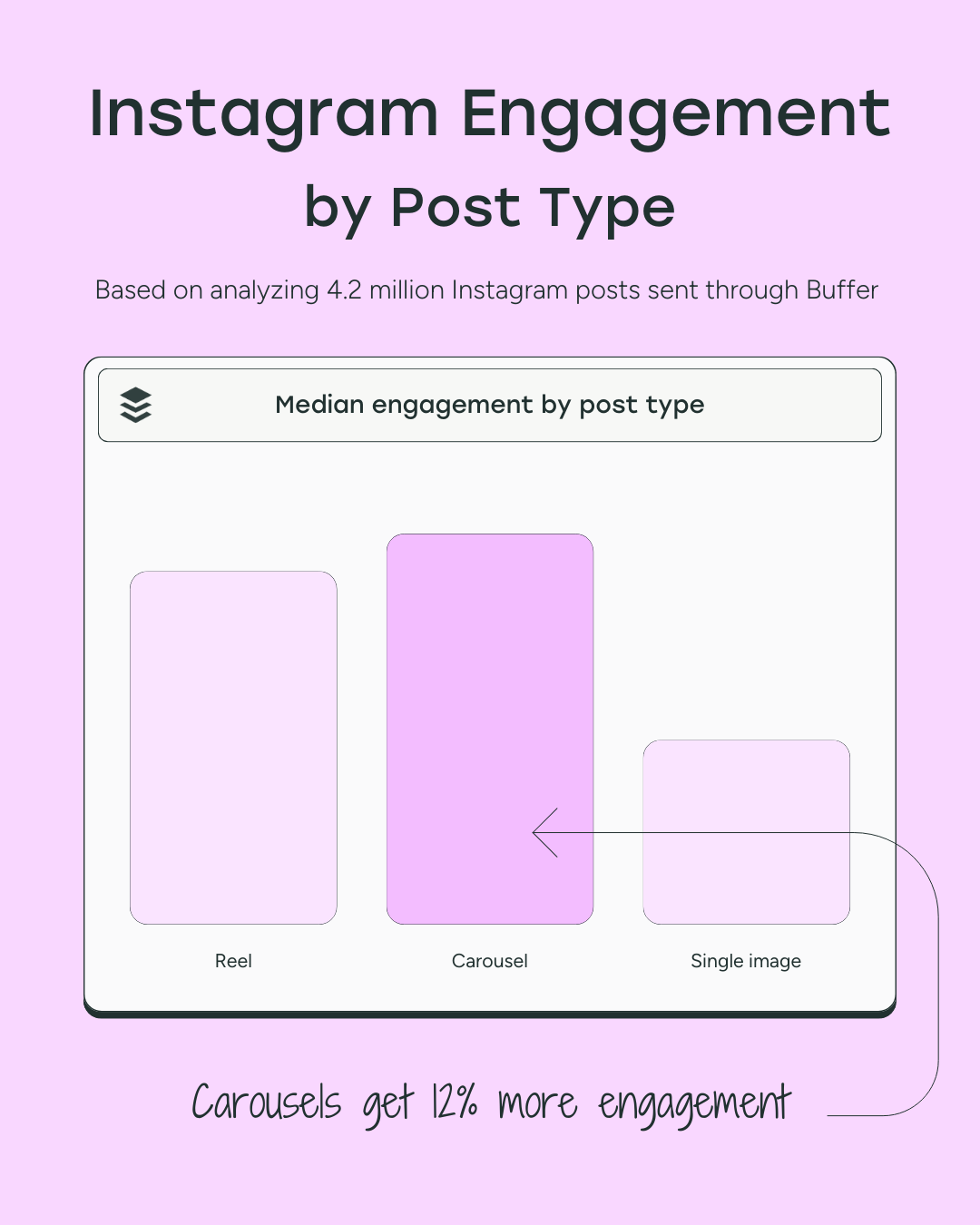

There are three things to consider given these findings.
One, to grow your audience and boost visibility on Instagram, use reels – they’re seen more often, especially by non-followers.
Two, to engage your existing community more deeply, use Carousels – they get more likes, comments, saves, and shares.
And finally, use photos more sparingly. They still have a role — but perform lowest on both reach and engagement. Better yet, put them in a carousel.
The social media landscape is constantly shifting, so to understand where creators and brands are focusing their attention, we analyzed millions of Buffer channel connections from 2022 to late 2024. Our data shows both the rise of new players and the staying power of legacy platforms.
Here’s how some of the biggest (and fastest-growing) platforms stack up:
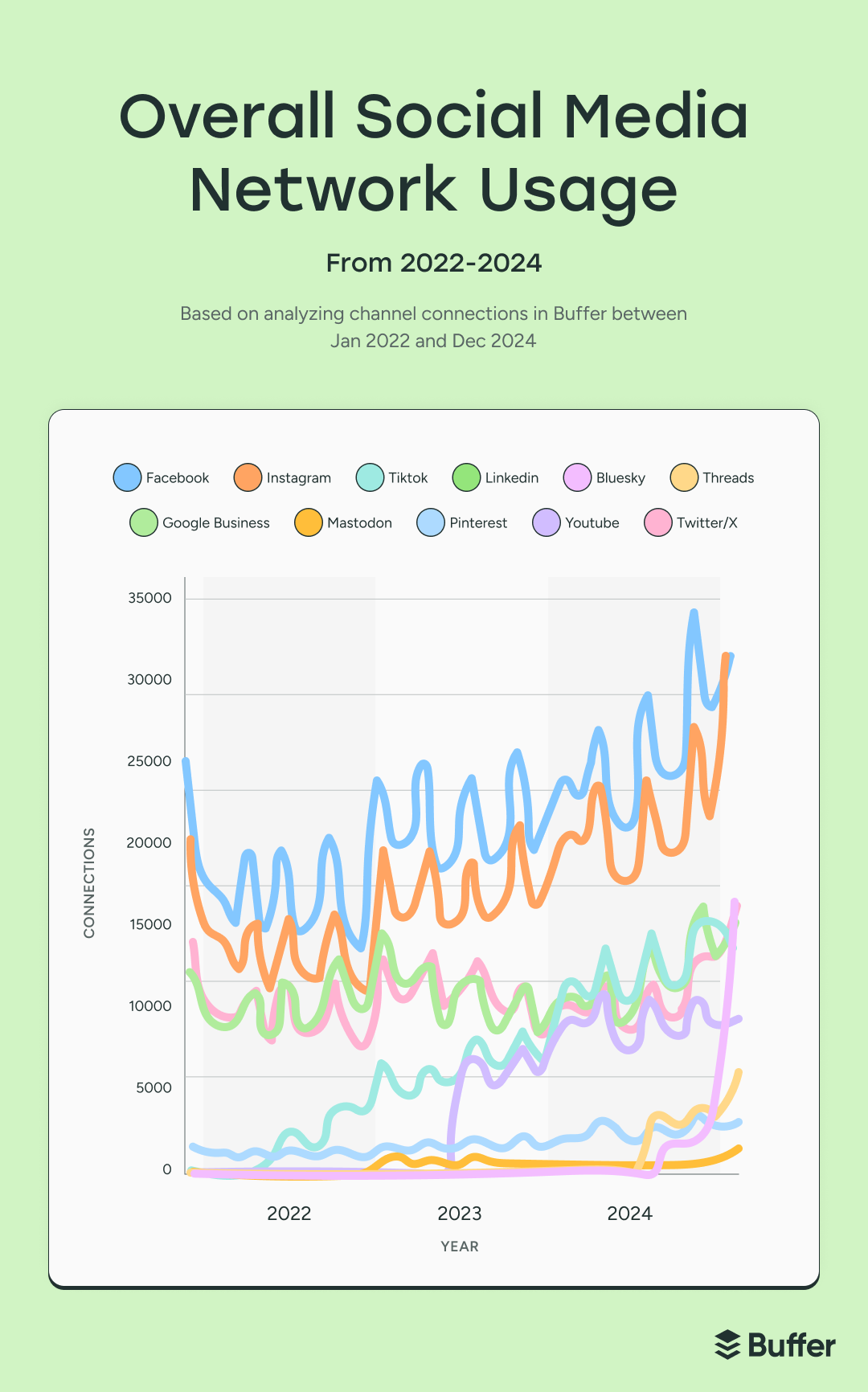

The social landscape is no longer about picking one winning platform — it’s about diversifying smartly. Threads and Bluesky demonstrate how quickly new platforms can emerge. Getting in early can give you a head start on reach and relevance.
But legacy platforms still matter. Facebook and Instagram continue to grow steadily, reminding us that the biggest audiences often reside where people already spend their time.
And video? It’s unavoidable. The surge in TikTok and YouTube Shorts shows that creators are prioritizing formats that drive visibility quickly.
In all of this, the most important thing to remember is to focus on where your audience is — and where they’re headed next.
The release and rapid rise of Threads kickstarted a new question among the text-first platforms: which sees the most engagement?
To answer that, we analyzed 10.2 million posts from 2024 to compare engagement performance on Threads and X (Twitter) via Buffer.
Threads posts have a median engagement rate of 6.25%, compared to just 3.60% on X. That’s a 73.6% increase in engagement — despite Threads having a smaller overall user base at the time of analysis.
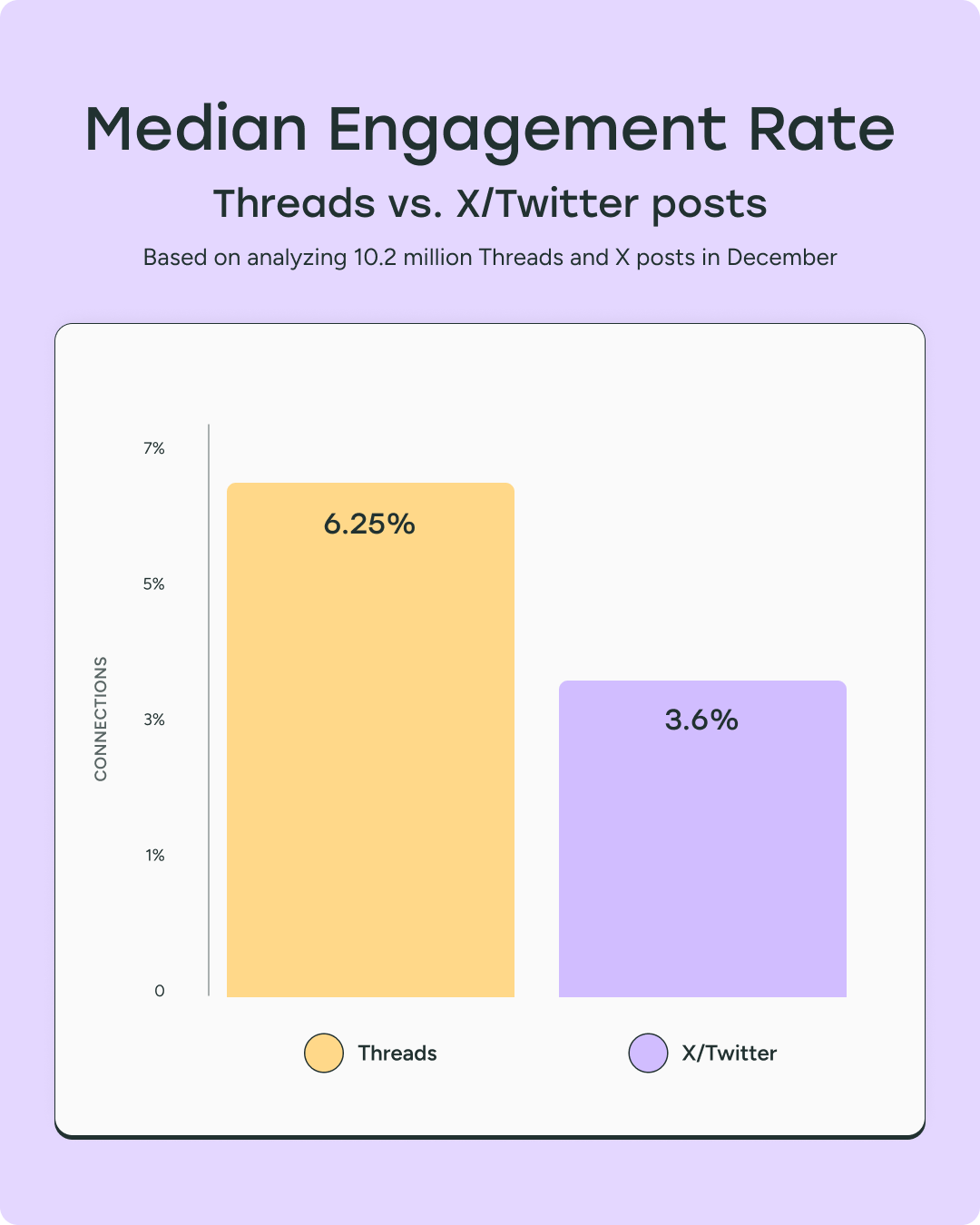

The average engagement rate was also higher on Threads: 4.44%, compared to 2.42% on X — a +83.5% uplift in average engagement.
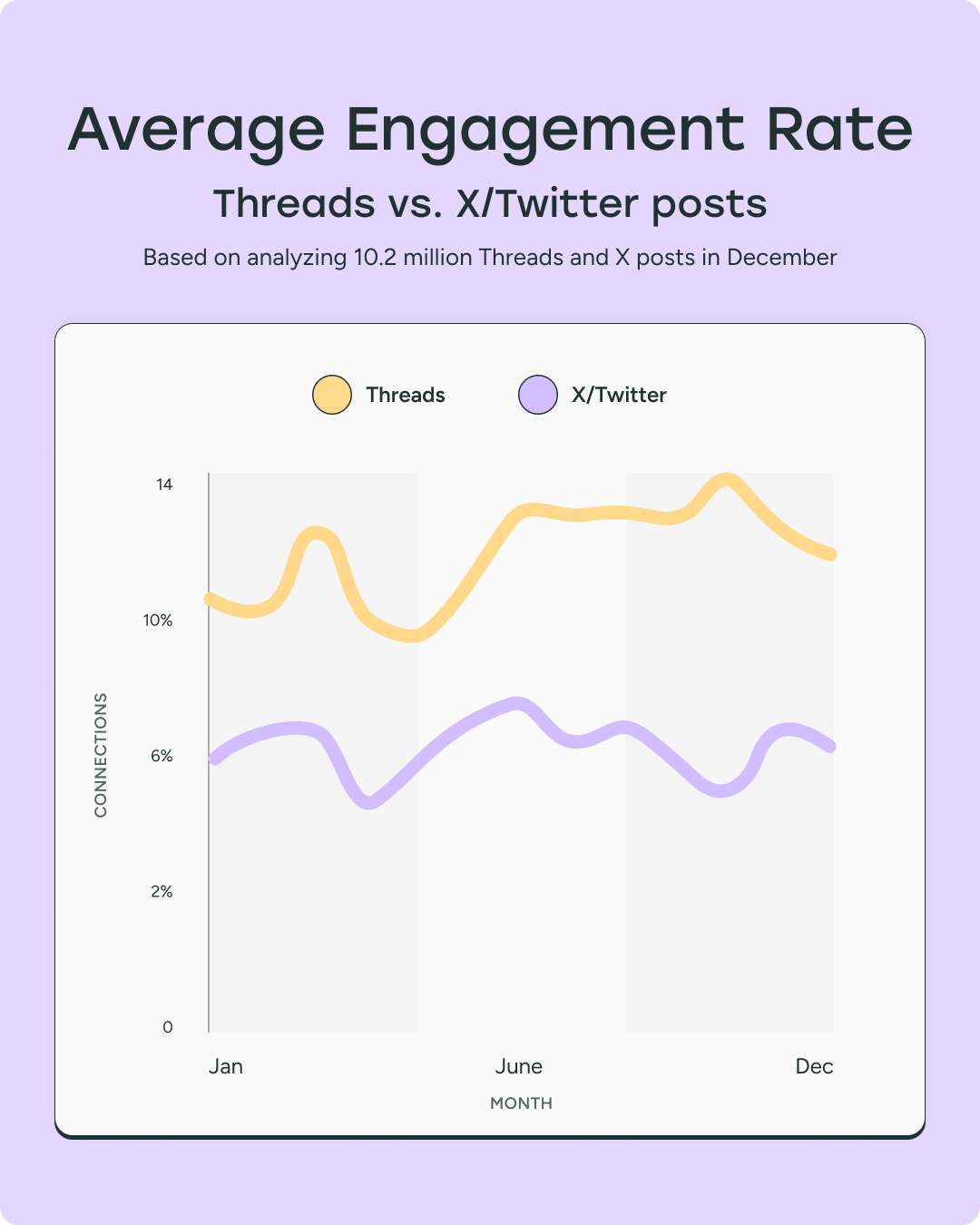

Why the gap? Engagement on Threads is being driven by its reply-first algorithm and relatively low content saturation, giving posts a longer shelf life and higher visibility.
While X still boasts a larger active user base and broader reach potential, the data shows that creators looking for engagement — especially from early adopters and niche communities — are more likely to find it on Threads.
If your content goal is connection and conversation, Threads offers significantly better engagement today.
But if you’re optimizing for news, virality, or reach, X still has strategic value — especially when paired with Threads.
Your best move? Cross-post thoughtfully and prioritize platforms where your community is most active.
Text-first platforms kickstarted social media as we know it and are always surging in popularity — but they’re not all built the same.
To compare how creators are showing up (and being seen) on Threads, X, and Bluesky, we analyzed 1.7 million posts from early 2025.
While they might seem interchangeable at first glance, the data reveals key differences in engagement dynamics.
The median post gets 4 engagements on all three platforms. So for the typical user, performance starts in a similar range.
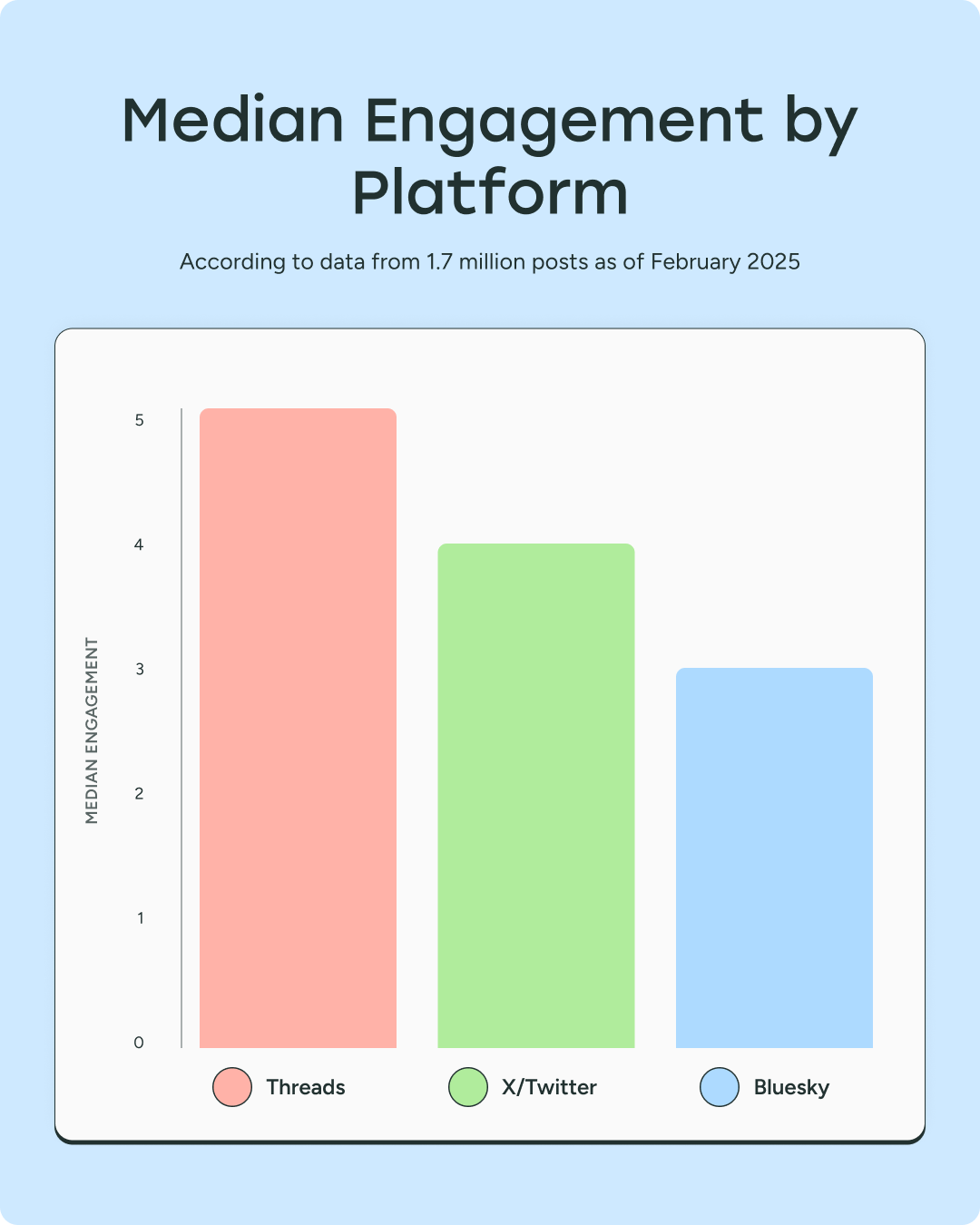

But when you look at average engagements, platform behavior diverges:
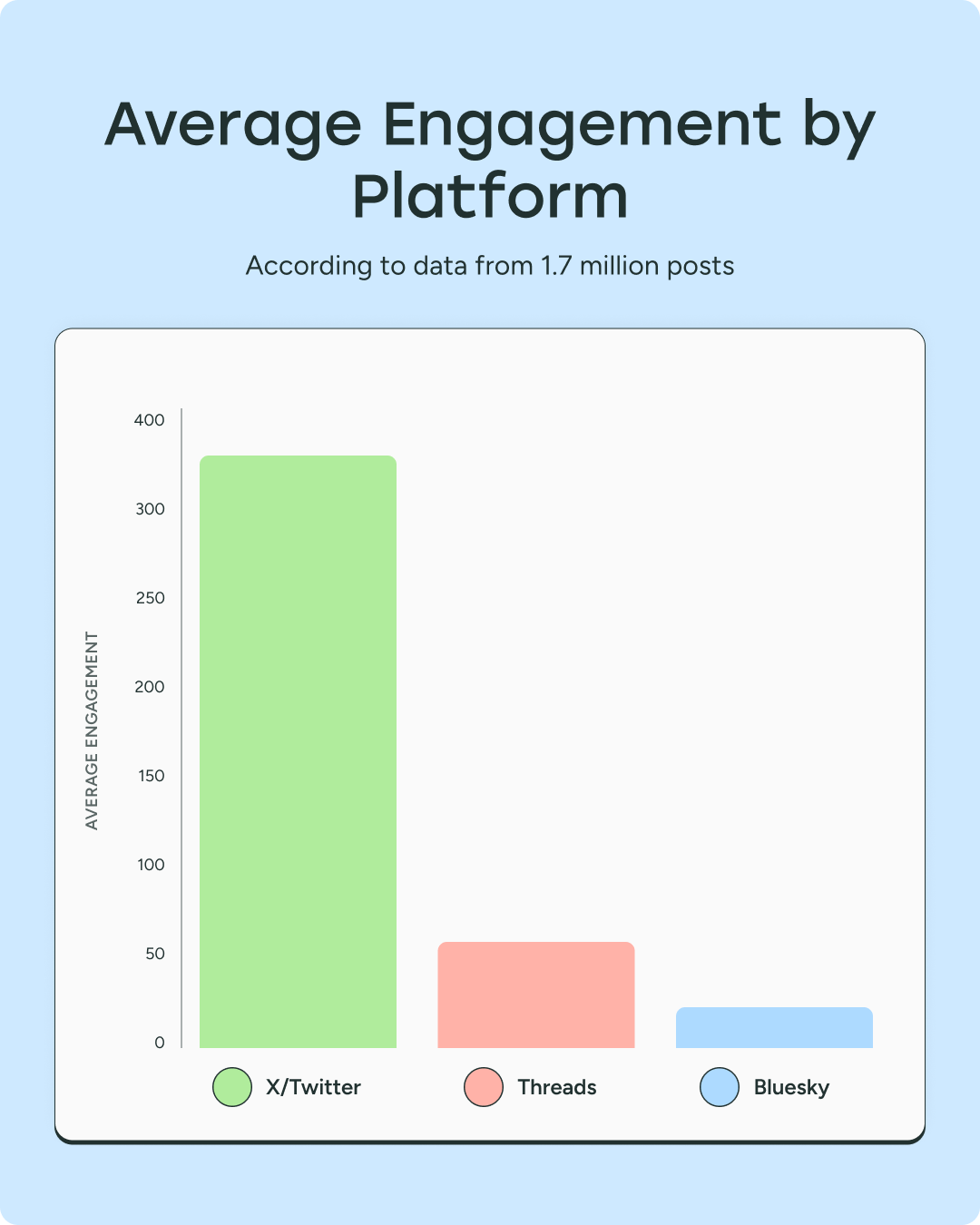

But why does it matter at all? It helps to make an informed decision about which platform to pick and what approach to take.
A multi-platform approach can give you both scale and depth. Combine the strengths of each platform:
And so you don’t duplicate efforts, explore cross-posting. Creators seeing the most success often cross-post with slight tweaks — repackaging ideas to match each platform’s vibe.
Our most popular question — answered with data from real user posts.
Buffer analyzed millions of posts across all major platforms to determine the best times to publish.
Below, you’ll find a breakdown of top-performing time windows by platform — plus links to dive deeper into each individual analysis.
The best time to post on Facebook is between 5–7 a.m. local time, with Mondays and Wednesdays driving the most engagement. Early morning scrolls remain effective, especially for content that sparks conversation.
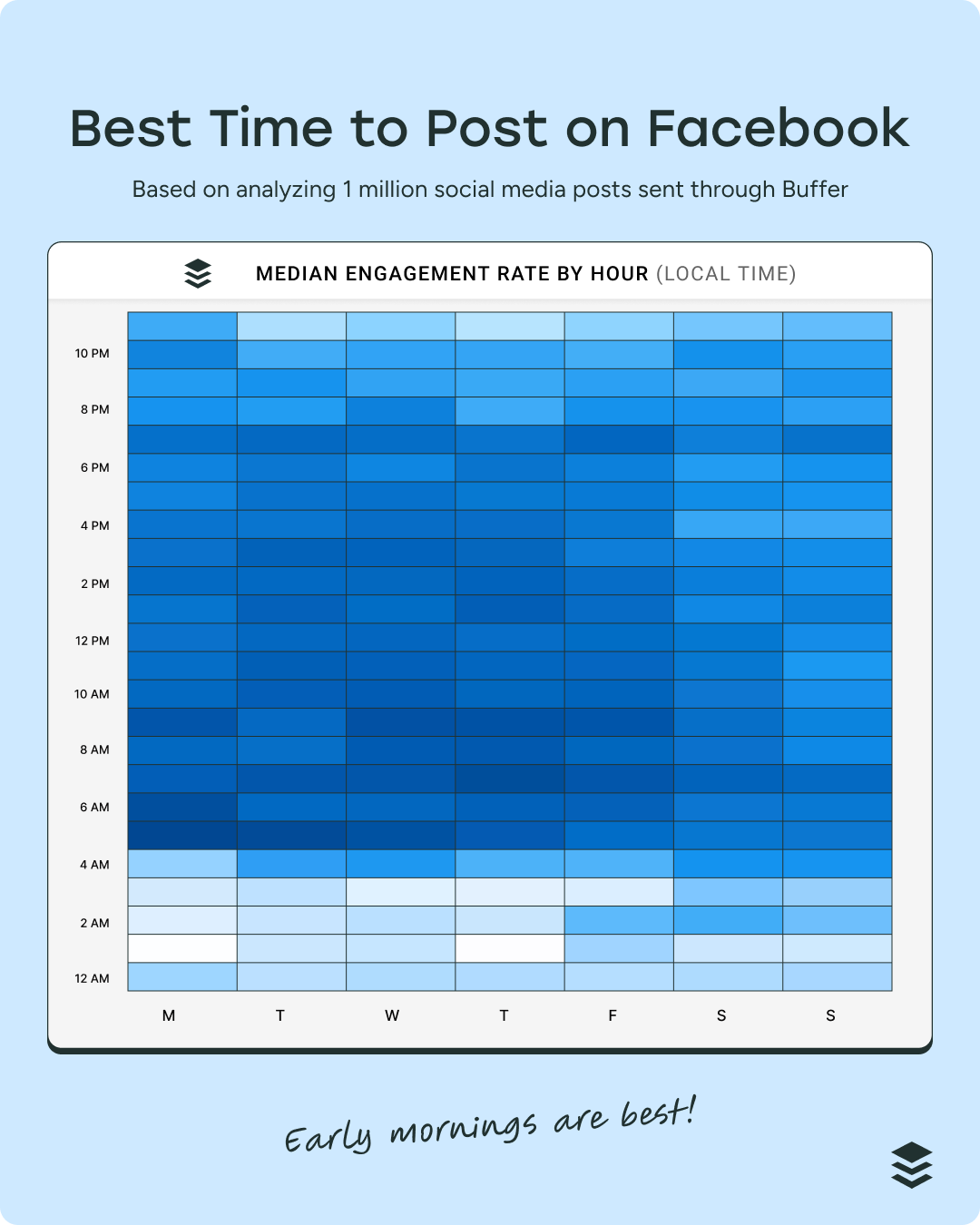

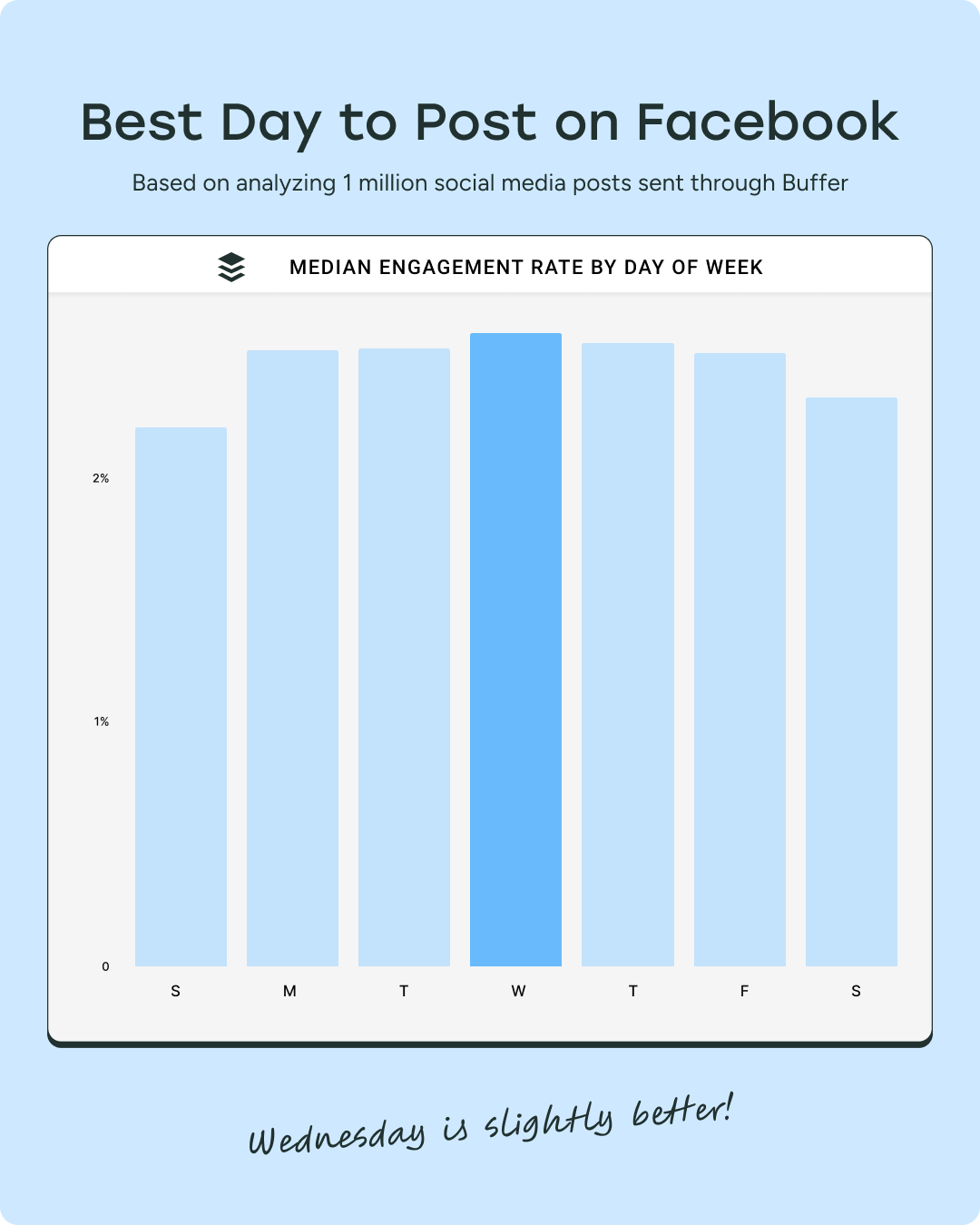

Instagram sees peak performance in the late afternoon, especially 3–6 p.m., with Fridays generating the most interactions. This is prime time for visual content and save-worthy posts.
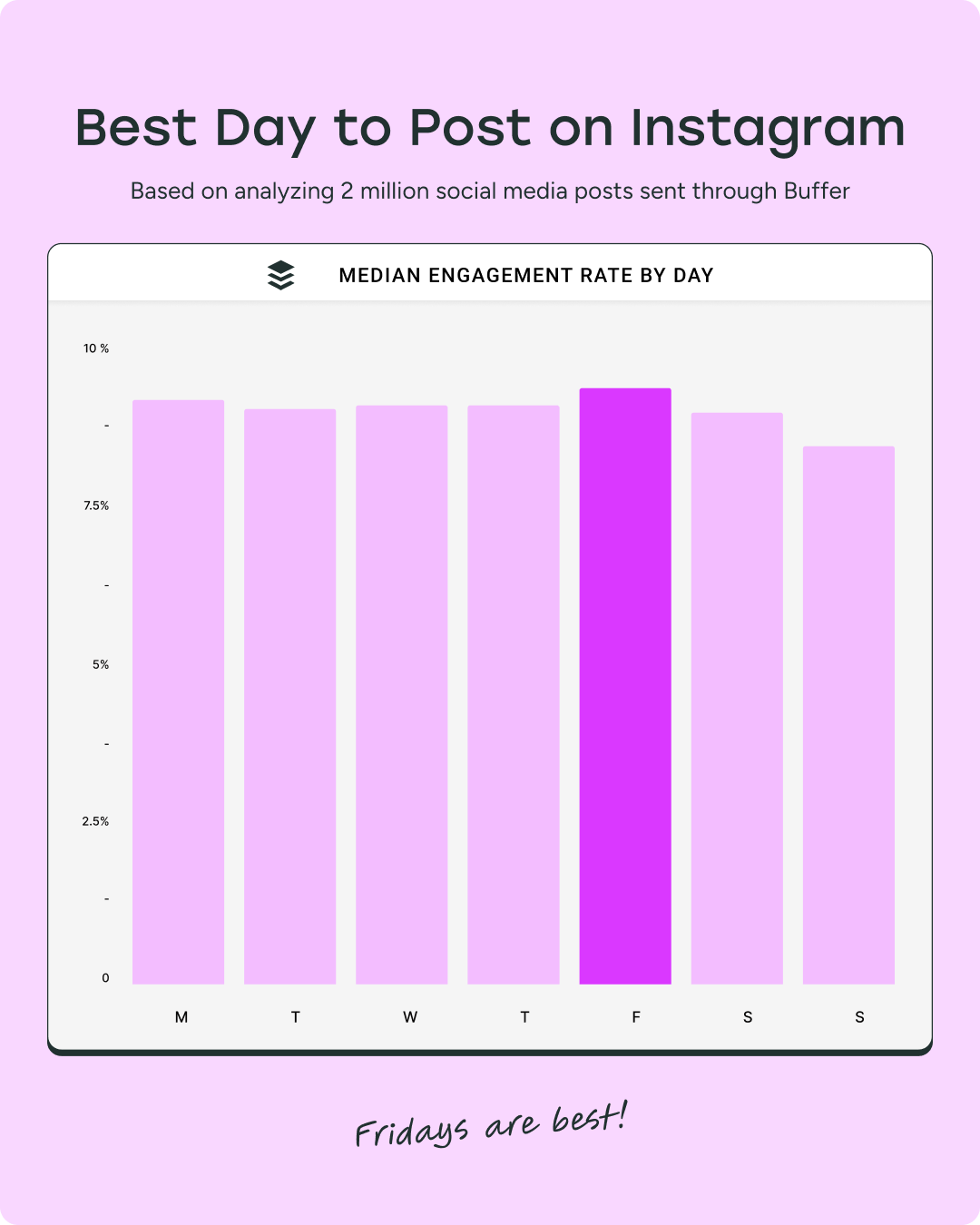

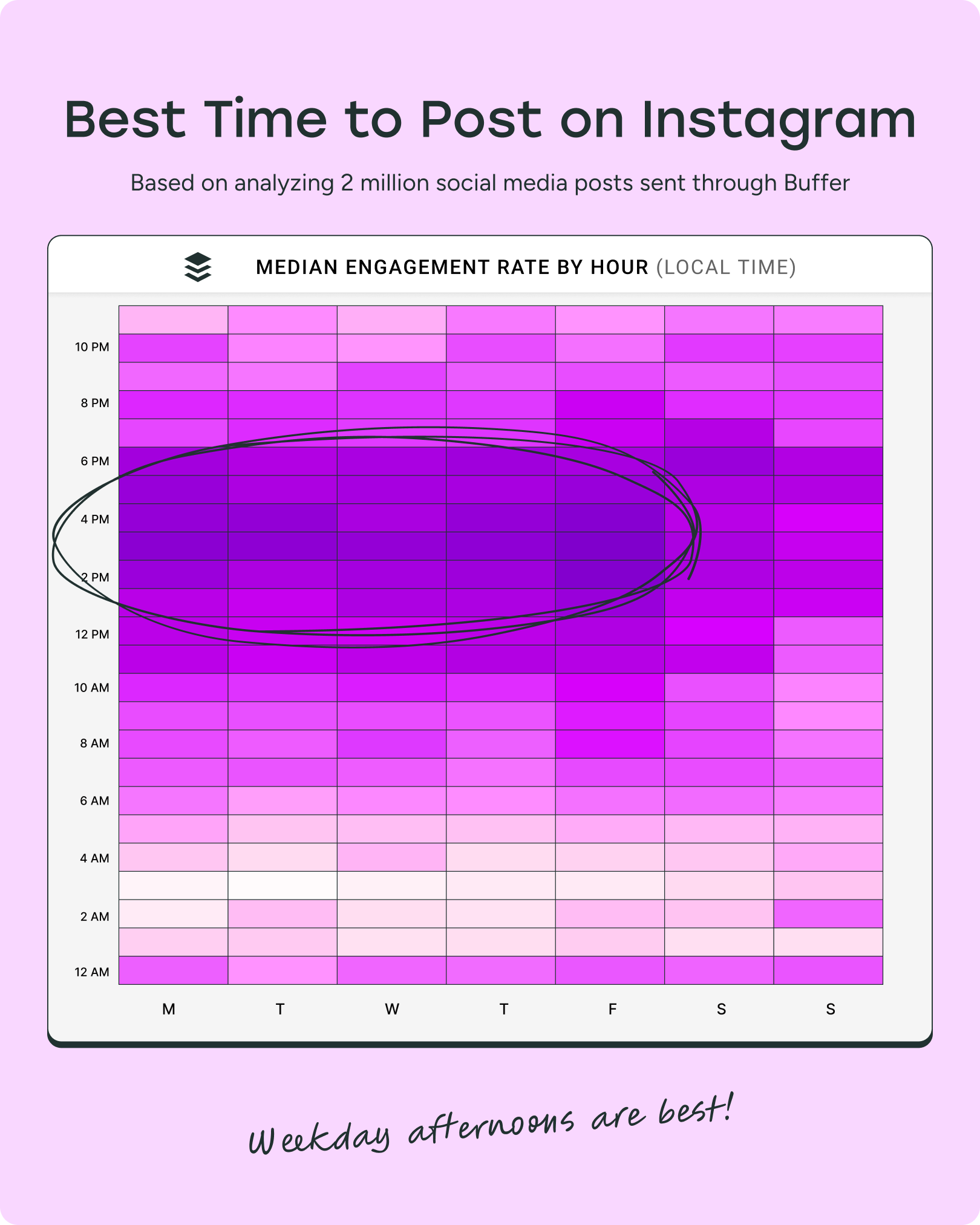

For LinkedIn, the optimal posting window is 7 a.m. to 4 p.m., with a noticeable spike around 10 a.m. on Tuesdays. Align your content with working hours to reach professionals in discovery mode.
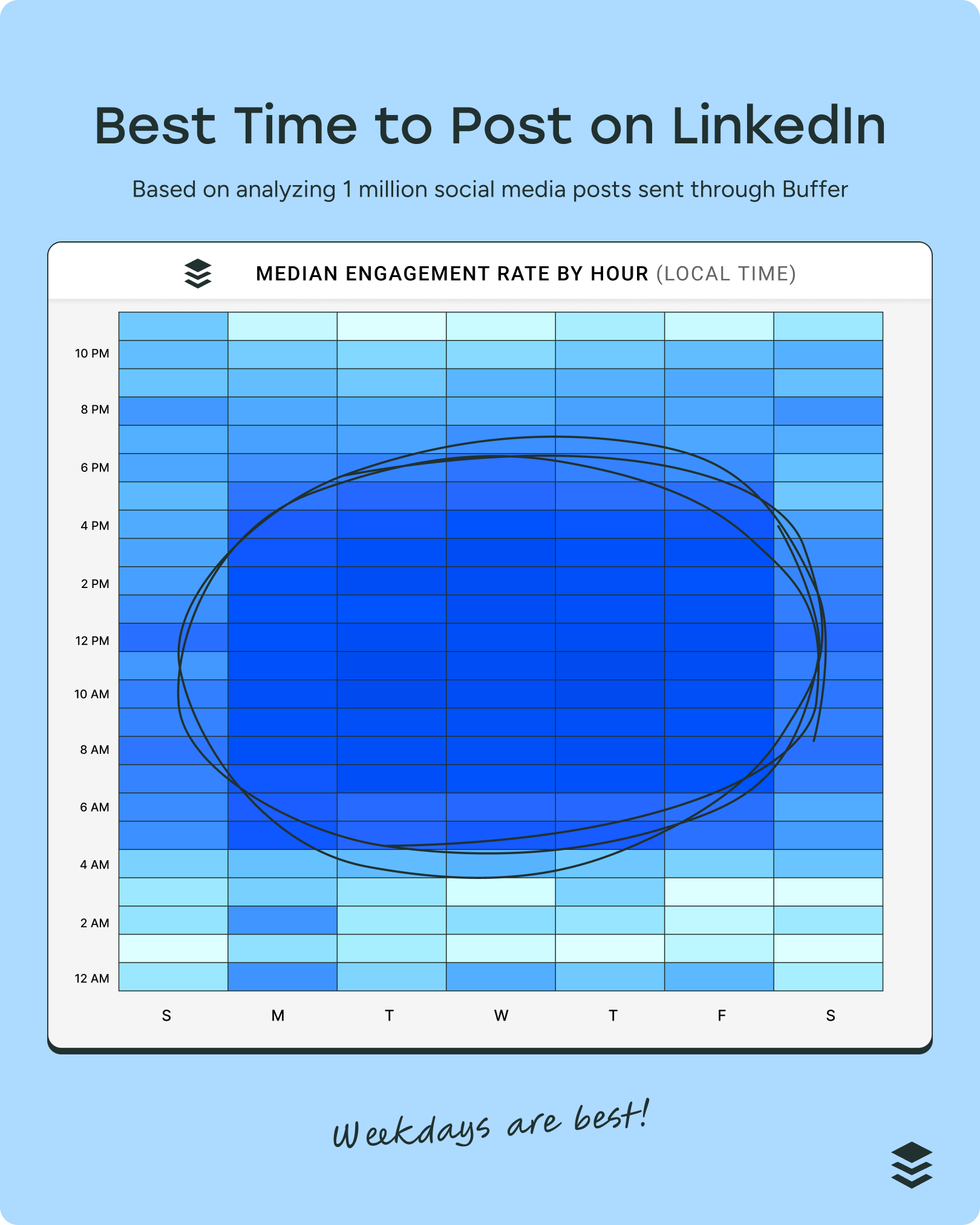

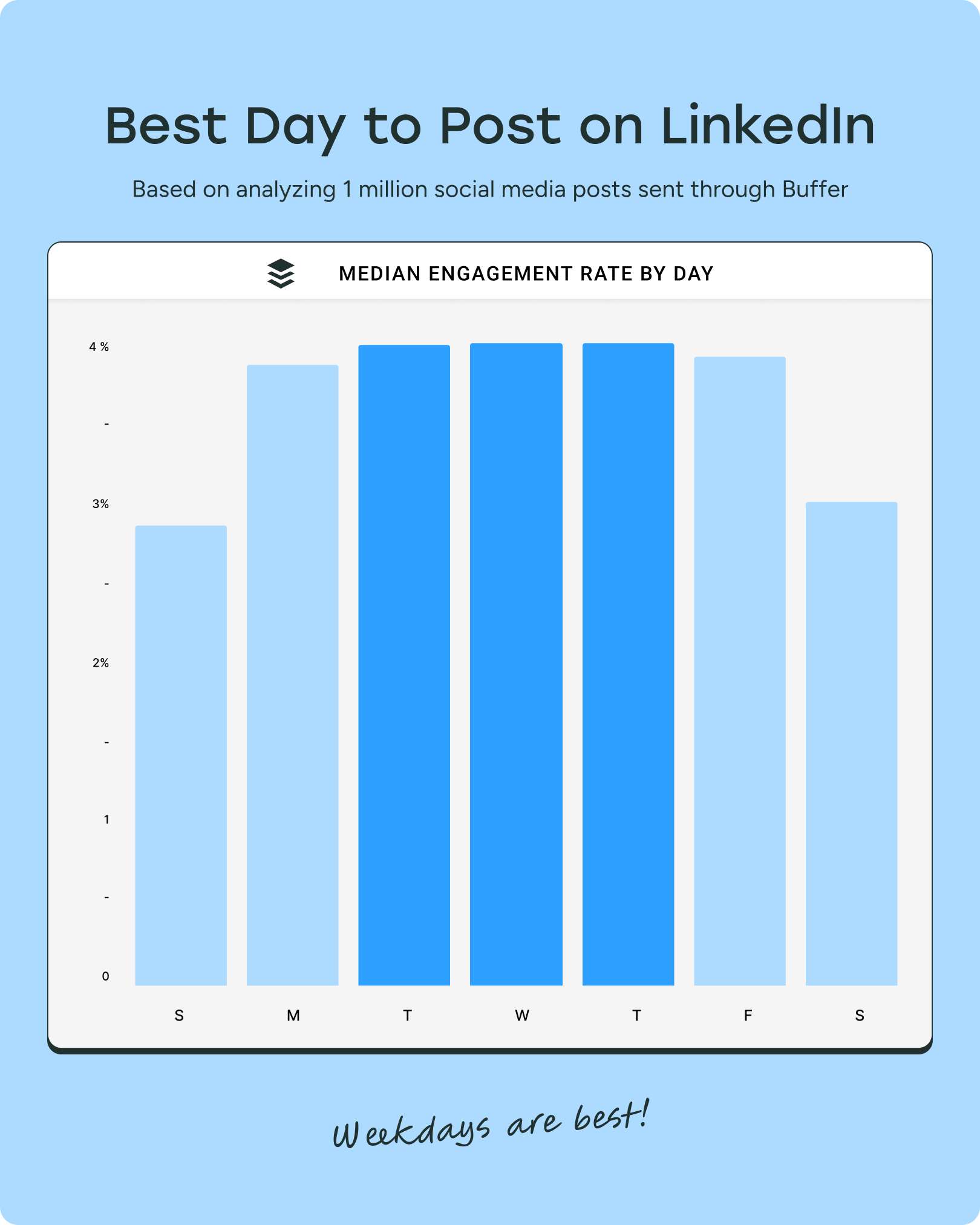

TikTok posts perform best when published in the late afternoon to early evening (4–7 p.m.), with Sunday evenings and midweek afternoons standing out. This reflects when users are most likely to watch longer-form video content.
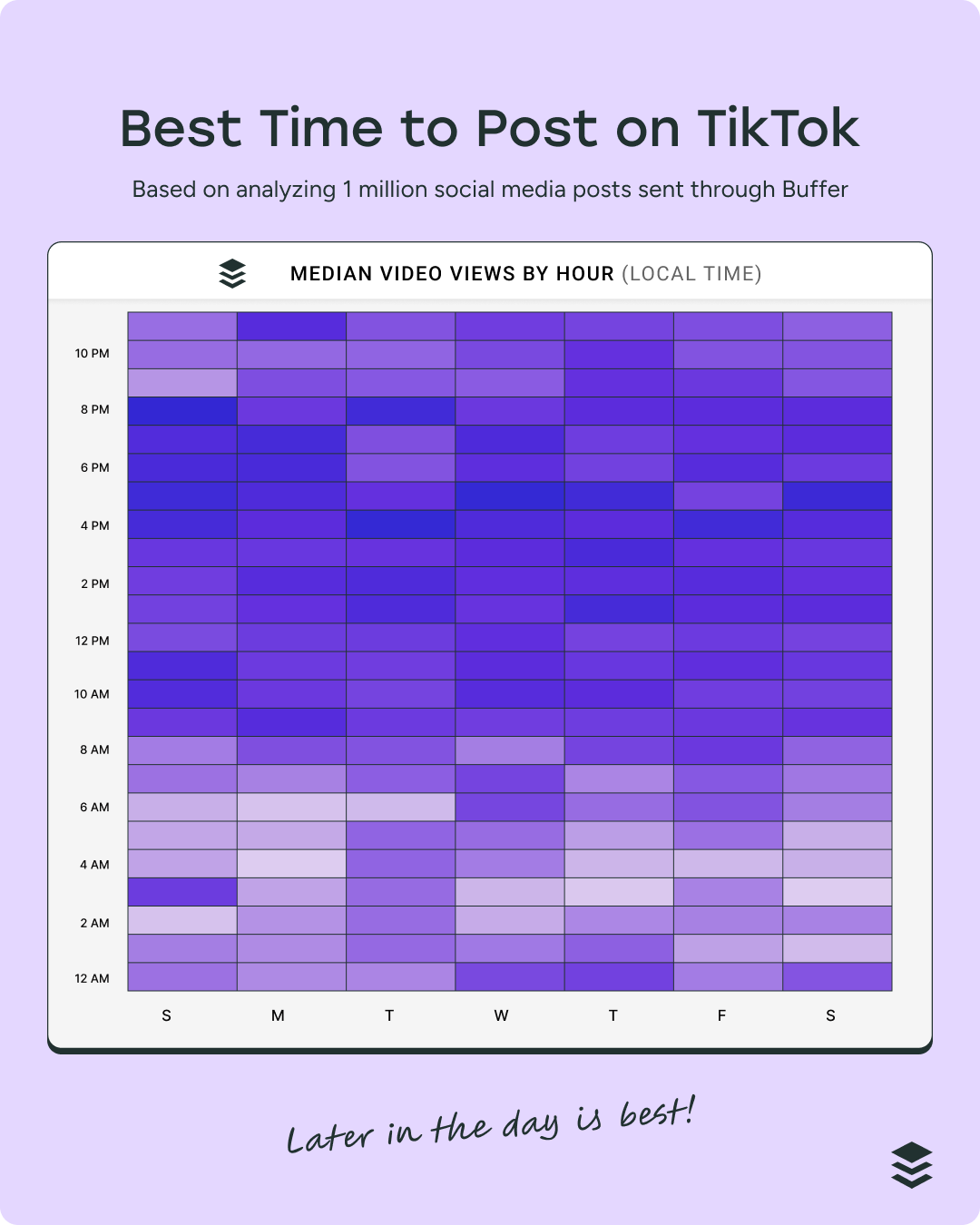

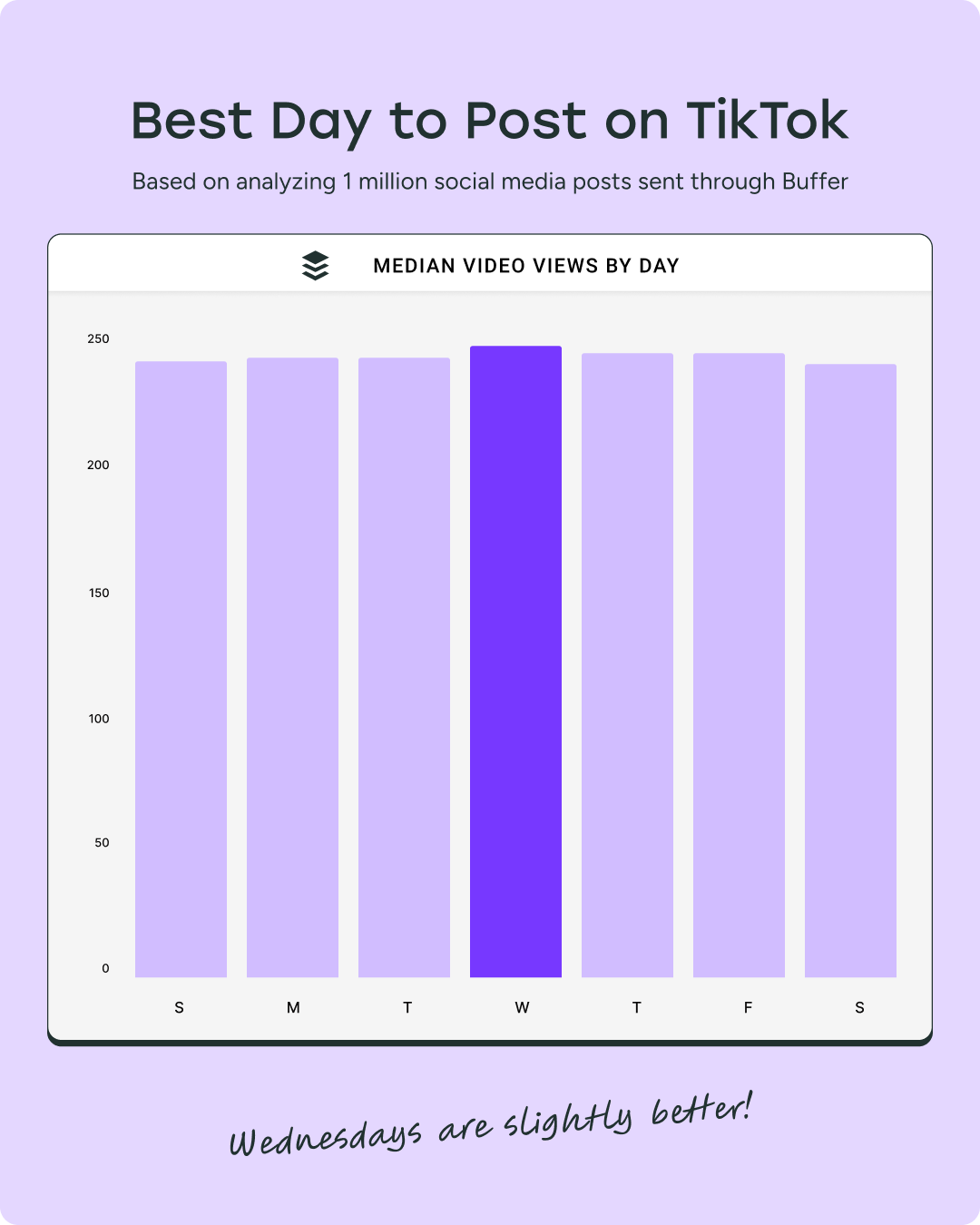

The best time to post YouTube Shorts is between 3–5 p.m., especially on Wednesdays, Thursdays, and Fridays. Posting ahead of peak watch hours boosts initial reach and retention.
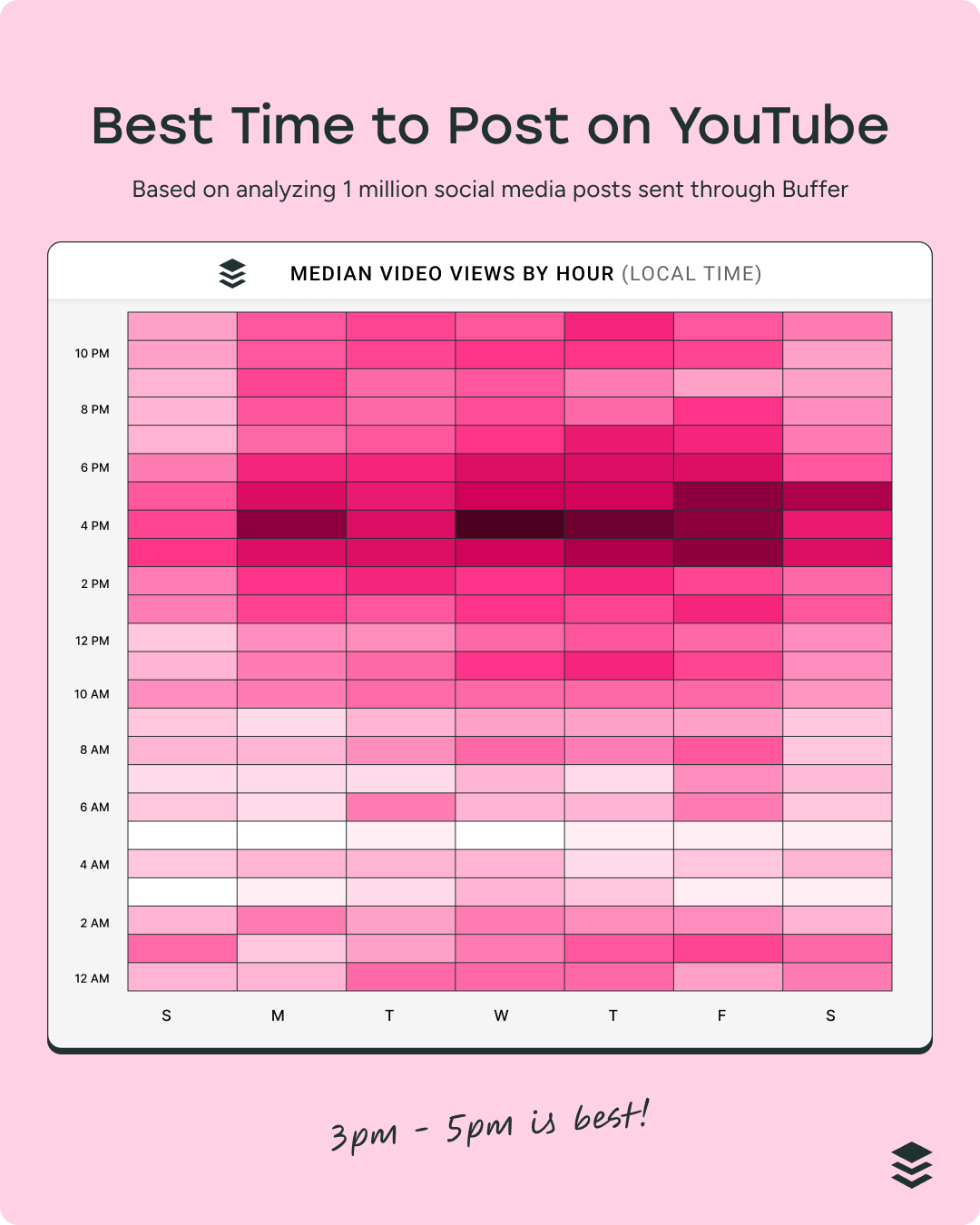

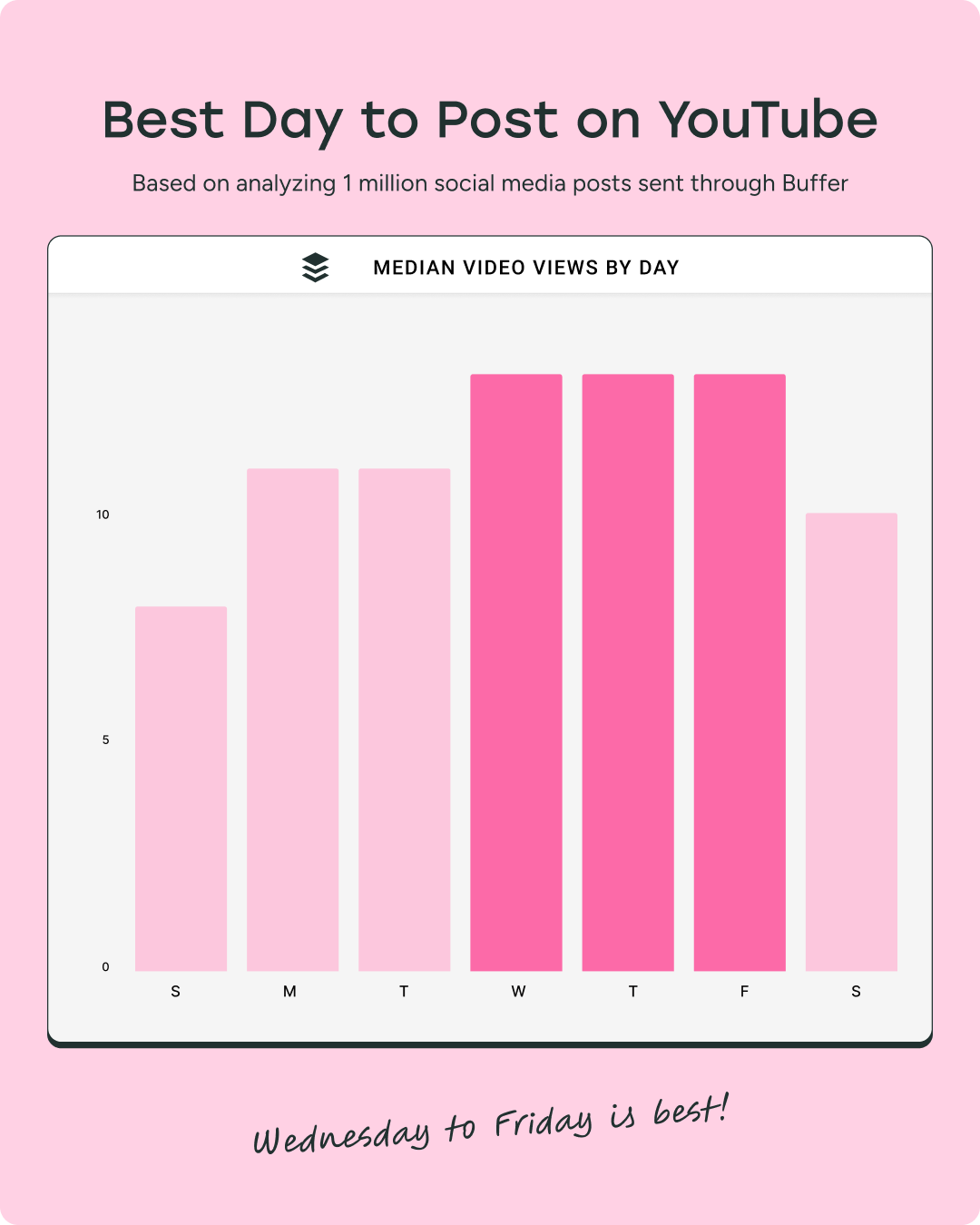

Threads sees strong engagement between 7–9 a.m., with an interesting spike on Sundays at 1 a.m. If you’re experimenting with early-morning or overnight content, Threads is worth testing.
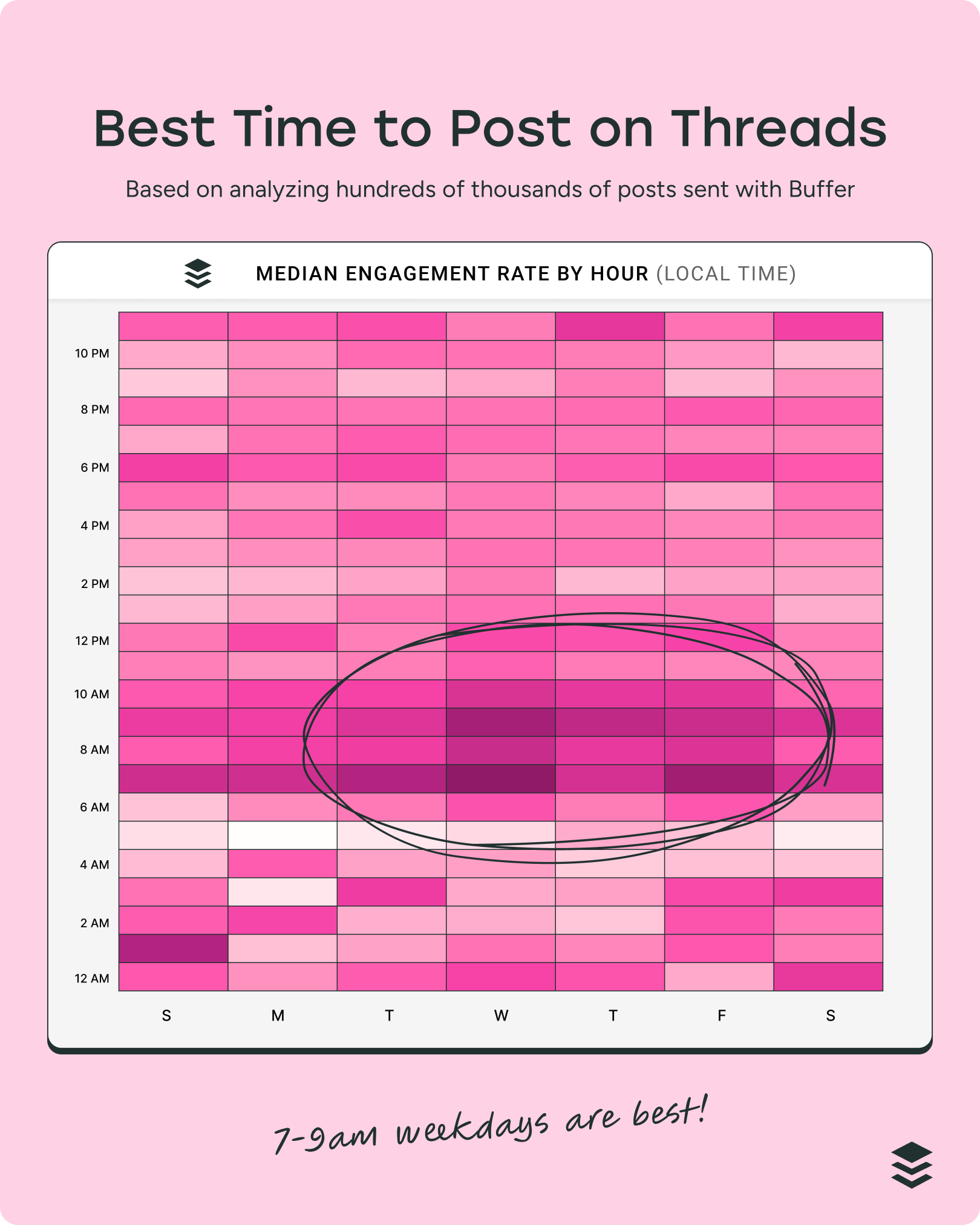

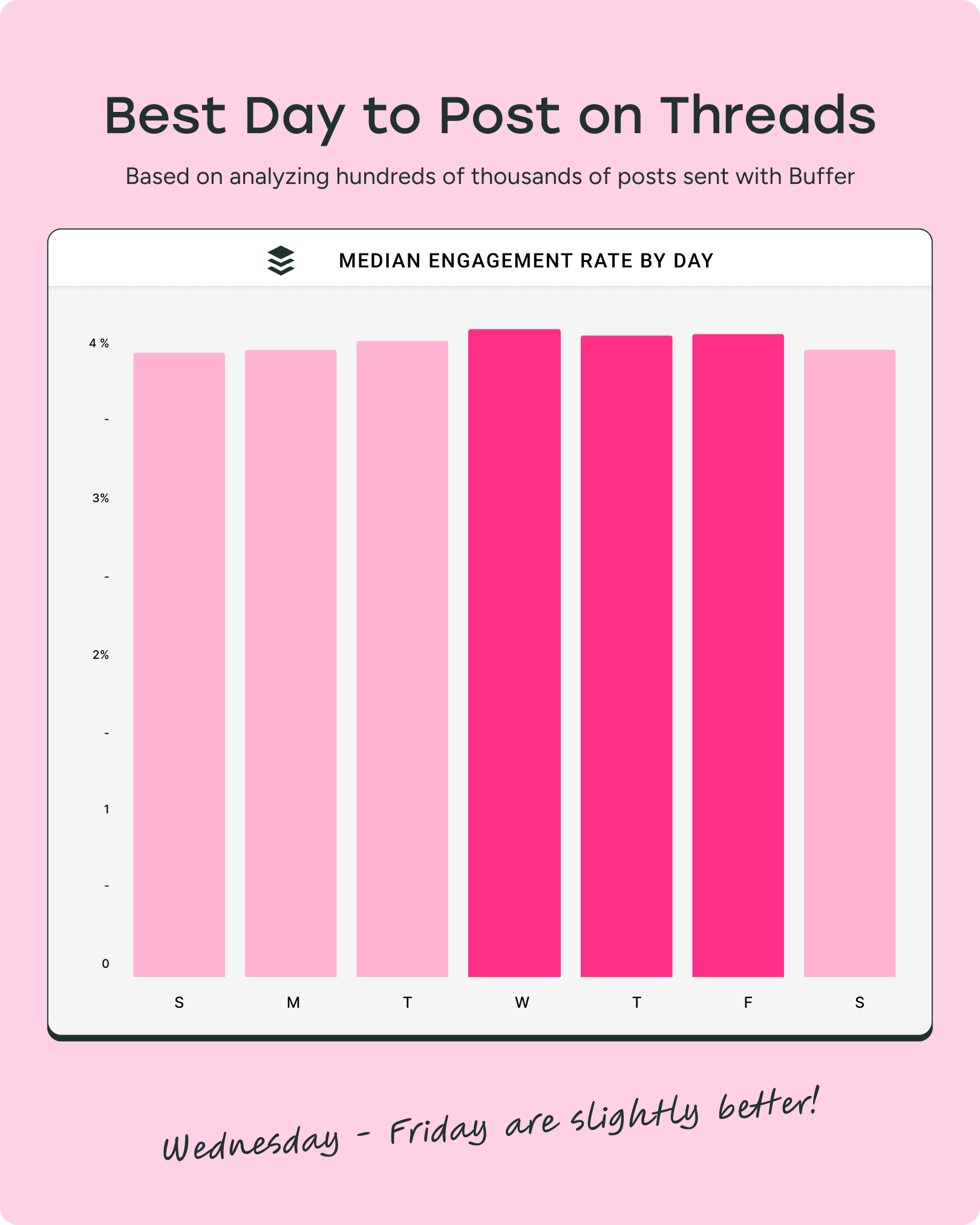

The ideal posting window on X is 8–10 a.m., with Wednesdays and Tuesdays seeing the highest engagement. Timely, text-driven posts tend to perform best during these early-day moments.
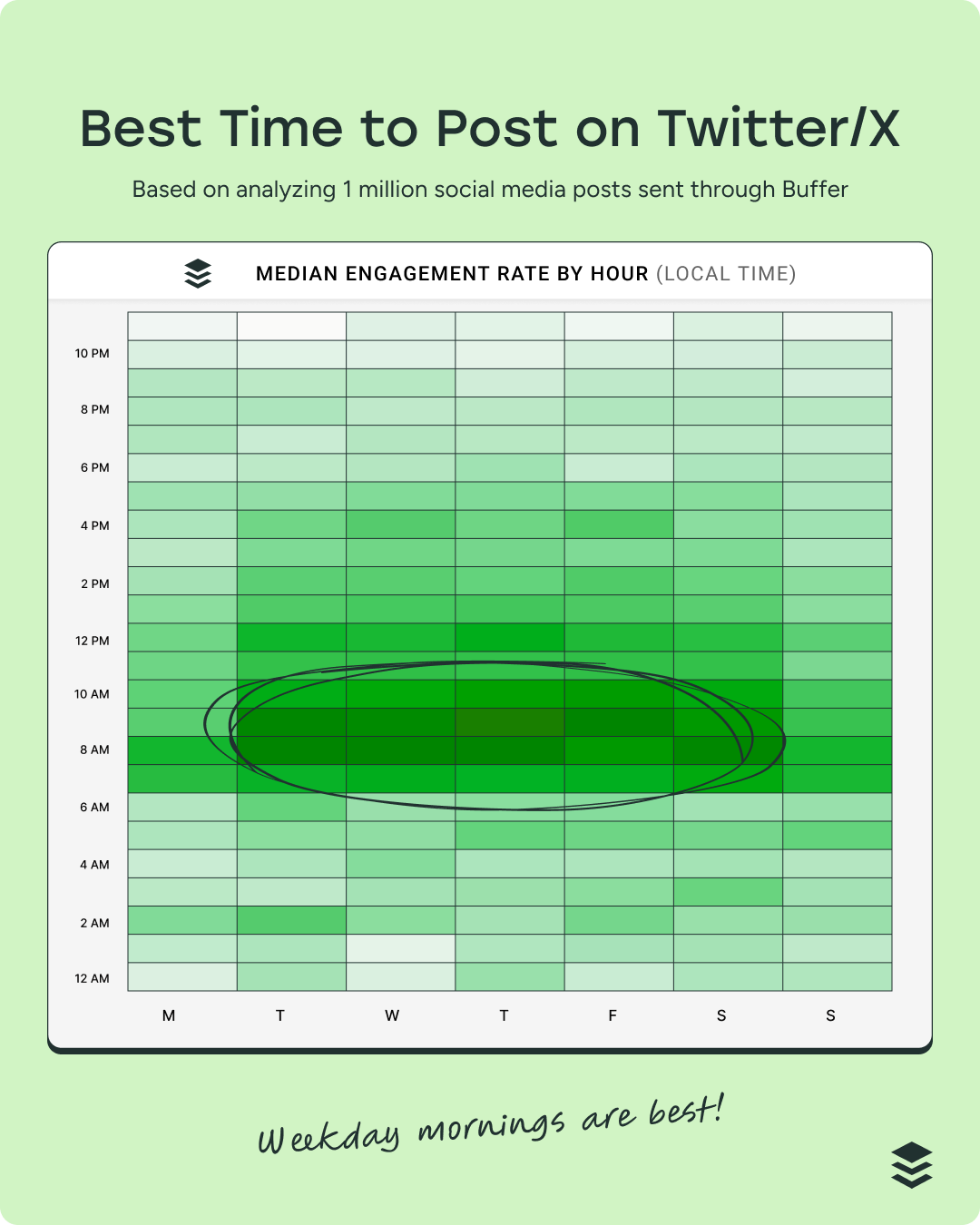

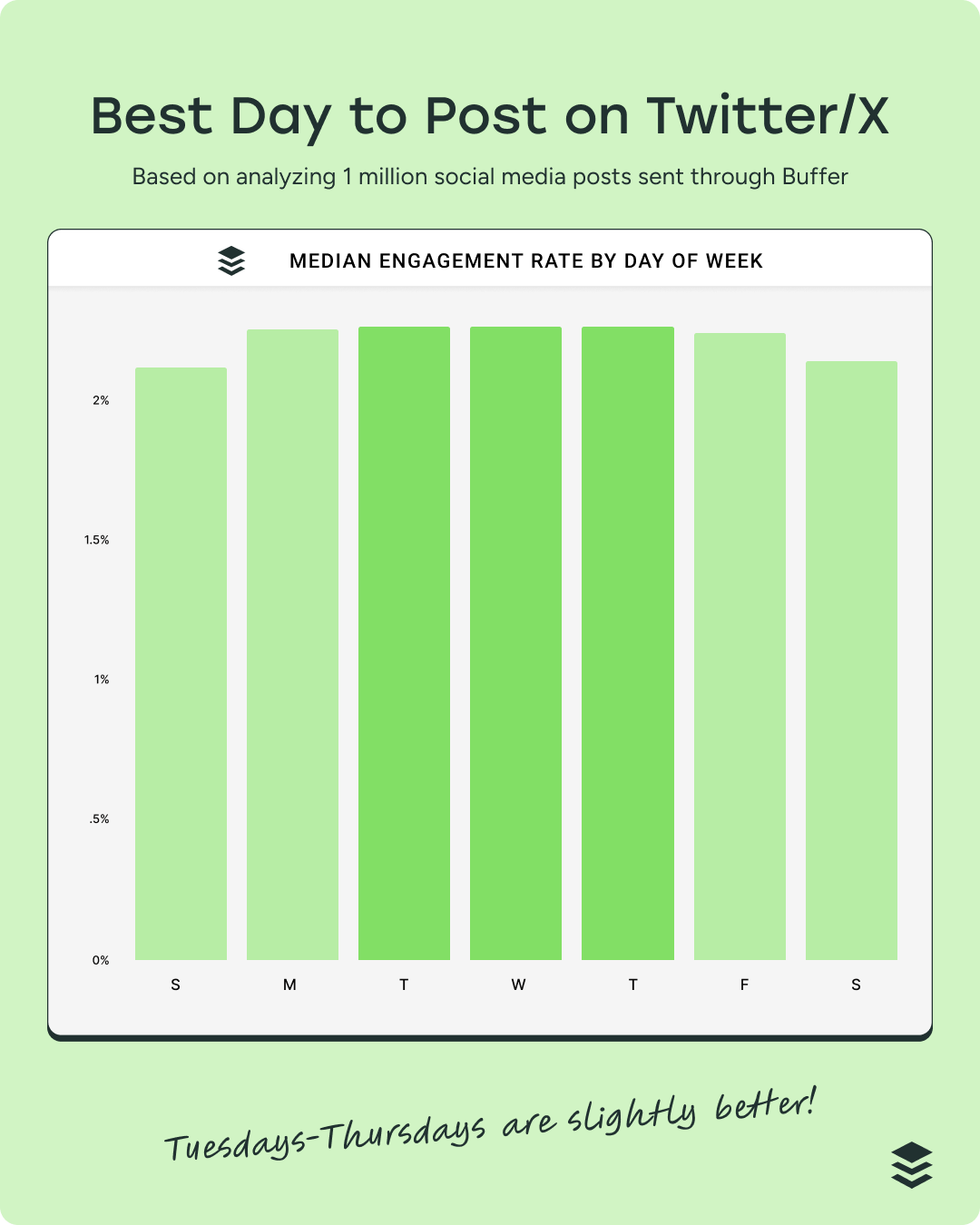

We’re always testing and publishing new reports based on real platform activity. Keep an eye on the latest findings to stay updated on our latest updates.